Cool and classic basses
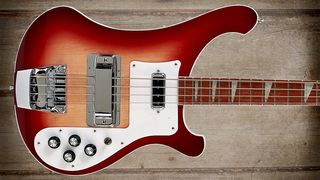
Rickenbacker 4003

PRODUCED : 1979 - Current
ORIGIN : USA
TYPE : Twin cutaway solid body, 4-string passive
BODY : Bound, Maple wings aside the neck block
NECK : Maple, through neck, 20 jumbo frets
SCALE LENGTH : 844.6mm (33 ¼ -inch)
FINGERBOARD : Rosewood, lacquered with perloid triangle inlays sometimes called Sailfins
HARDWARE : Chrome, Rickenbacker solid bridge/tailpiece, Schaller open gear 'shamrock' tuners, string damper
PICKUPS : 2 Rickenbacker Singlecoils
CONTROLS : Volume & Tone for each pickup plus 3-way selector switch
FEATURES : Bound body, Mono and Rick-O-Sound stereo outputs, distinctive white scratchplate
FINISHES : Fireglo, Jetglo, Mapleglo, Midnight Blue, White
COMMENTS: When Rickenbacker introduced the 4003 bass the 4001 was still in production, in fact it lasted until 1985 and with relatively little between the two visually and general sound characteristics, its very existence may seem curious.
The truth is, the 4001 had a few design problems - particularly with the truss rod adjustment cavity at the headstock. As the neck was very slim there was actually very little wood around this cavity, headstock breaks were always a danger (personal experience here) and neck bowing could be a problem.
The 4003 was designed to take care of that by adding extra meat to the whole neck. Of course this gave it a rather more substantial feel, so the new designation was justified. Rickenbacker also improved the dual truss rod system and altered the electronics by removing the bridge pickup capacitor and improved 'hotter' pickups, which are much better balanced than on the 4001.
Later versions of the 4003 would include a push/pull pot to engage this replaced capacitor. This bass masters the iconic looks and sound that Rickenbacker basses are known for, particularly when engaging Rick-O-Sound, which provided a stereo output jack so that you can run each pickup into a designated amplifier. But whether mono or stereo this will grunt and growl like no other, although as McCartney proved it can also sound very sweet. Also available as the 4003S unbound mono version, 4003FL fretless, 4003S/5 unbound 5-string and 4003S/8 unbound 8-string, with all S-versions having dotted inlays.
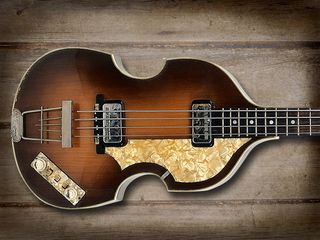
Hofner 500/1 Violin Bass
BASS EXPO Could there be any better way to celebrate the glory of the bass guitar than with a series of profiles of some of the most iconic instruments ever to grace stages and recording studios across the globe? We don't think so. Kicking off our series of bass profiles is the four-string that a certain mop-topped Liverpudlian used to take the world by storm in the early 1960s...

Hofner 500/1 Violin Bass
PRODUCED: 1956 – current
ORIGIN: Germany
TYPE: Hollow violin-shaped body, 4-string
BODY: Spruce top, flamed maple back & sides, fully bound
NECK: Maple, glued-in neck, 22 fine frets plus zero fret
SCALE LENGTH: 762mm (30-inch)
FINGERBOARD: Rosewood, white dot inlays
HARDWARE: Chrome trapeze tailpiece, rectangular pearloid control plate and matching scratchplate (often removed), rosewood bridge has slots in the top to take four small lengths of fret wire to act as crude string saddles, small guitar-sized open gear tuners
PICKUPS: Two Hofner ‘staple’ units on this 1962 version
CONTROLS: Two volume controls and three slide switches
FEATURES: The rosewood bridge has slots in the top to take four small lengths of fretwire to act as crude string saddles, although the body and headstock are bound the fingerboard is not
FINISHES: Brown Sunburst
COMMENTS: By the time that Paul McCartney popularised the Violin Bass it had already undergone several changes. By 1961 most notably the oval control plate was replaced by a rectangular one, extra switches were added and the smooth black single coil pickups were replaced by the staple ones we see here.
Initially these two new pickups were placed close together towards the neck but by spreading them apart as here. At the outset there were 20 frets, then 21, but when it reached 22 the bass finally came of age and has remained in production ever since. Along the way it’s been called the Beatle Bass and the Cavern Bass, had gold fittings, ebony fingerboard and even active circuitry but that’s just gilding the lily in our opinion. Classic is best.
Hear it here: The Beatles - I Saw Her Standing There
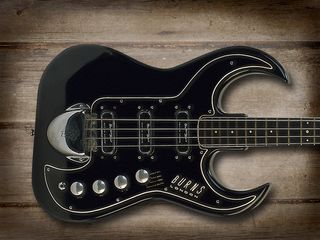
Burns Black Bison Bass

ORIGINALLY PRODUCED: 1962-64
ORIGIN: UK
TYPE: Solidbody, Passive 4-string
BODY: Sycamore, twin cutaway
NECK: Maple, bolt-on, 22 medium frets plus zero fret at nut
SCALE LENGTH: 851mm (33.5-inch)
FINGERBOARD: Ebony, bound, white dot inlays
HARDWARE: Chrome, 4-saddle bridge, fully adjustable, Van Ghent open gear tuners with large black plastic buttons
PICKUPS: Three Burns Ultra Sonic Bass units
CONTROLS: Volume, tone, 2-way selector (A/B) & 4-way tone selector (Wild Dog, Treble, Tenor, Bass)
FEATURES: The cutaway horns curved upwards from the flat plane of the body, cover plate over bridge, string damper fitted
FINISHES: Predominantly black (hence name) but white with white scratchplate and custom colours were also available
COMMENTS: This was the first full-scale bass produced by Jim Burns and in spite of its considerable weight it became very popular with session players of the time. This was the first of many variations and was produced as a companion to the Bison guitar.
The original guitar had four pickups but the bass only ever had three, fortunately! In keeping with the theme, black flatwound strings were fitted as standard and contributed to the very powerful and big booming sound. However clear notes were never a problem thanks to the legendary Wild Dog Treble setting!

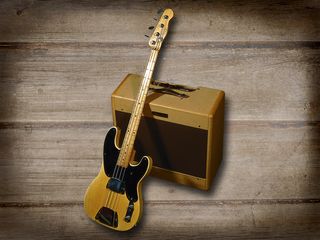
Fender Precision Bass
PRODUCED: 1951-1954
ORIGIN: USA
TYPE: Solidbody, passive 4-string
BODY: Twin cutaway slab, ash
NECK: Solid maple, U-profile, skunk stripe covers truss rod, 20 fine frets
SCALE LENGTH: 864mm (34-inch)
FINGERBOARD: No separate board, part of the maple neck, black dot inlays
HARDWARE: Chrome, 2-saddle bridge, open reverse gear tuners
PICKUP: Exposed single-coil 4-pole
CONTROLS: Volume & tone on separate chromed control plate
FEATURES: Telecaster-style headstock, large single-ply black pickguard, separate chromed metal control plate, through-body stringing, chrome cover plates over bridge and pickup, finger rest with single screw in centre, edge mounted jack socket
FINISHES: Blonde
COMMENTS: This is the original design for the Precision so had the job to convince upright bass players to change allegiance! The connection to the Telecaster is obvious but the additional upper cutaway was introduced in order to give the instrument much better balance.
It had its faults however so was comparatively short-lived in this early format but it was the beginning of the most successful bass guitar ever produced. It’s been continually tweaked over the years as we shall see but remains as an iconic and magnificent instrument.
Hear it here: Elvis Presley - Jailhouse Rock
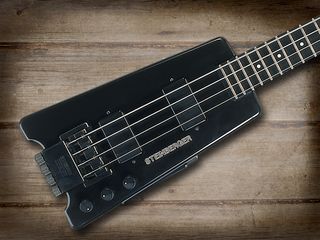
Steinberger XL-2
PRODUCED: 1980-present
ORIGIN: USA
TYPE: Headless solidbody, 4-string, active electronics
BODY: Synthetic, one-piece neck/body although separate body top was bolted on
NECK: 24 jumbo frets & fretless available
SCALE LENGTH: 864mm (34-inch)
FINGERBOARD: Phenolic, white dot inlays
HARDWARE: Black, fully adjustable 4-saddle bridge/tuner tailpiece
PICKUPS: Two humbucking EMG units
CONTROLS: 2 volumes & 1 tone
FEATURES: Swivel strap holder at back plus a hinged leg rest on lower body edge, uses double ball-end strings, no lighter in weight than a conventional bass
FINISHES: Predominantly black although other colours are available. The early white ones were termed albinos.
COMMENTS: For synthetic read epoxy resin reinforced with carbon graphite and glass fibre. This was the Ned Steinberger model that caused excitement throughout the industry. A tiny full-scale bass by anyone’s standards at only 38-inches overall length but with a monster sound in spite of its minimalist looks.
Initially four models were available the H1 & H2 (high impedance with one or two DiMarzio pickups) and the L1 & L2. These were low impedance, active basses with a dominating sound that literally blew the H models away! The L-2/5 five-string version was introduced in 1982 and both models were replaced by the XL-2 in 1984. And in spite of a company buyout in the late '80s it’s the XL-2 that’s still with us today.

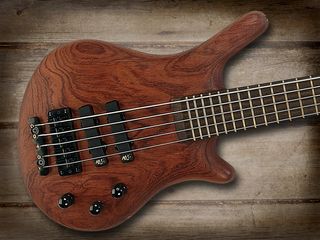
Warwick Thumb five string
PRODUCED: 1985 - Current
ORIGIN: Germany
TYPE: Carved double-cutaway body, laminated neck-through, active 5-string
BODY: 2-piece bubinga
NECK: 7-piece afzelia & wenge, 26 medium frets
SCALE LENGTH: 864mm (34-inch)
FINGERBOARD: Wenge, no poison markers on fretboard, ebony and fretless also available
HARDWARE: Black fully adjustable bridge, Brass ‘Just-A Nut,
PICKUPS: Two MEC J-style units
CONTROLS: Stacked Volume & active mid range cut/boost, push/pull active/passive switching, stacked tone with bass & treble cut/boost, panning control
FEATURES: Bridge has separate tailpiece, Straplocks fitted, batteries housed in control cavity, distinctive angle on the tuners
FINISHES: Natural and colours
COMMENTS: Warwick are well known for their quality of build and general attention to detail and like much of their bass range the Thumb is available in several different configurations as far as woods used, pickup types and their positioning is concerned.
However the twin pickup, electronics and general neck through construction remains and although the original 4-string Thumb was something of a beast a general slimming down on proportions and the introduction of the 5-string has undoubtedly made it the flagship instrument for the company. Available in 4, 5 & 6-string versions and with bolt-on construction.
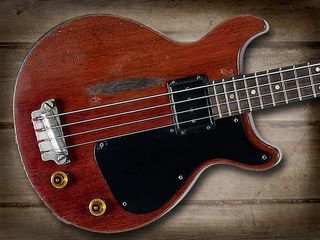
Gibson EB-0 Bass
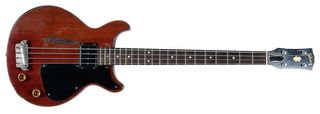
ORIGINALLY PRODUCED: 1959-61
ORIGIN: USA
TYPE: Solid slab body, twin cutaway, 4-string
BODY: Mahogany
NECK: Mahogany, set neck, 20 medium frets
SCALE LENGTH: 775mm (30.5-inch)
FINGERBOARD: Rosewood, white dot inlays
HARDWARE: Chrome bridge/tailpiece, single-saddle bridge with strings anchored on baseplate, banjo-style tuners
PICKUPS: One large double-coil humbucker with black cover
CONTROLS: Volume & tone
FEATURES: The ‘banjo’ style headstock means that the tuning keys face backwards
FINISHES: Cherry red only
COMMENTS: This was the first version of the EB-0 and modelled on the Les Paul Junior guitar. When the guitar became the SG the EB-0 was given the same facelift. With the single humbucking placed against the neck this had a big fat sound further enhanced by the significant mass of the slab mahogany body. Its weight was certainly one of its downfalls.
Although popular in America it was not so easy to find in the UK however Glen Cornick of Jethro Tull used one for a while and that certainly increased the interest level over here. Occasionally these appear with a chrome plate over the strings to support the wrist, but the earliest versions don’t have one. The EB-1 came first but this was cheaper, hence the EB-0 model number in keeping with Gibson's price-related standard.
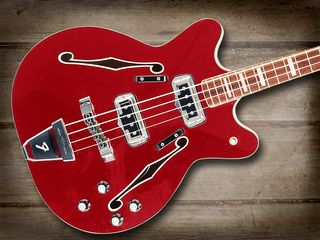
Fender Coronado II Bass

PRODUCED: 1966-1971
ORIGIN: USA
TYPE: Hollowbody, twin cutaway, 4-string
BODY: Bound arched
NECK: Maple, bound, set neck, 21 medium frets
SCALE LENGTH: 775mm (30.5-inch)
FINGERBOARD: Rosewood, bound, white pearloid block inlays
HARDWARE: Fancy trapeze tailpiece with Fender F, chunky bridge with individual saddles, open gear tuners with oval blades (although some sported regular ‘shamrock’ blades)
PICKUPS: Two single-coil DeArmond units with adjustable pole pieces
CONTROLS: 2 x volume, 2 x tone, selector switch
FEATURES: Bound f-holes, rounded off Fender headstock finished in black, symmetrical thumb/finger rests
FINISHES: Candy apple red, tobacco sunburst, three-tone sunburst, antigua, custom colours with matching headstocks and this was also the time of natural wildwood
COMMENTS: No prizes for guessing that this hollow body was Fender’s answer to the popular Gibson EB-2. Two models were made, the single pickup Coronado I and the tonally superior Coronado II. They were designed by Roger Rossmeisl who was known for his outlandish Rickenbacker designs from the 1950s.
Coronado basses were not overly popular at the time and prone to feedback so this lack of initial interest makes it hard to find one today. Roscoe Beck used one for a video shoot with Robben Ford and it looks very cool in action. These basses were light in weight and fitted with La Bella flat wound strings as standard. Used with modern EQ pedals or compression can sound really fat.
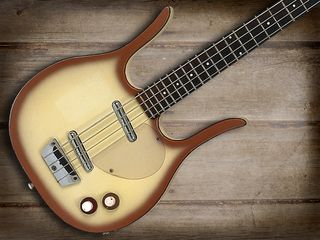
Danelectro Longhorn Bass

ORIGINALLY PRODUCED: 1958-69
ORIGIN: USA
TYPE: Hollowbody, passive 4-string
BODY: Masonite, lyre-shaped, vinyl edging strip
NECK: Maple, bolt-on, 24 fine frets
SCALE LENGTH: 749mm (29.5-inch)
FINGERBOARD: Rosewood, white dot inlays
HARDWARE: Bridge is a single rosewood saddle mounted onto a chrome plate.
PICKUPS: Two lipstick tube pickups
CONTROLS: Two dual concentric volume/on-off, original wooden ‘pointer’ knobs were soon replaced by round ones
FEATURES: Coke bottle headstock, regular guitar tuners, aluminium nut
FINISHES: Bronze & white sunburst
COMMENTS: The body construction is a laminated pinewood frame with hardboard (masonite) back and front stuck in place. Curiously the neck pocket was extended from the body further up the back of the neck for added stability.
Longhorns were very wallet friendly at the time and a significant quantity of instruments were sold in Sears Roebuck catalogues in the States under the Silvertone brand. The Lipstick pickups really were purchased lipstick cases and featured an alnico bar magnet core with the coil wound around, which was then covered in tape before inserting into the metal casing.
Initially both pickups were placed close together towards the neck but they were soon moved to bridge and neck positions for hollower sounds. They were adjusted for height from the back of the body. The bridge adjustment was equally as crude using the three screws that connected it to the body, but it worked.
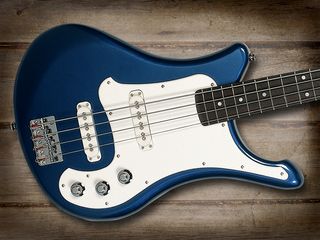
Yamaha SB-Series bass

PRODUCED: 1966-71/72
ORIGIN: Japan, Nippon Gakki factory
TYPE: Solidbody, reversed twin cutaway, 4-string
BODY: Alder
NECK: Maple, bolt-on, 20 medium frets & fretless available
SCALE LENGTH: 800mm (31.5-inch)
FINGERBOARD: Rosewood, bound, white dot inlays
HARDWARE: Chrome cover-over bridge/tailpiece, 4-saddle bridge, open gear tuners
PICKUPS: Two single-coil units with white plastic surrounds
CONTROLS: Volume, tone & balance
FEATURES: string mute fitted, headstock colour matches body, finger rest below strings for thumb playing
FINISHES: 3-tone sunburst, various sparkles
COMMENTS: The original SB-2 had a more conventional twin-cutaway body but it was the reverse body design of the revamped SB-2A that really caught the attention. In spite of the reverse body shape this is a relatively well-balanced bass thanks to the slim headstock and it was this distinctive shape that earned it the epithet of the Yamaha Samurai Bass!
Curiously, Yamaha used to stamp the serial number into the rosewood fingerboard towards the body end. With such a widespread for the positioning of the pickups this bass is capable of producing super hollow and funky sounds, but its delivery is generally full and warm as the angled neck pickup is set to favour the neck for the top strings.
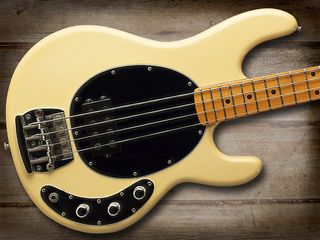
Music Man StingRay - pre Ernie Ball

ORIGINALLY PRODUCED: 1976-1980
ORIGIN: USA
TYPE: Solidbody, active 4-string
BODY: Alder for sunburst or coloured finishes, ash for naturals, twin cutaway
NECK: Maple with walnut skunk stripe, bolt-on, 21 medium frets
SCALE LENGTH: 864mm (34-inch)
FINGERBOARD: Maple with black dot inlays, rosewood optional and ebony on fretless versions
HARDWARE: Chrome, raised tail 4-saddle bridge, separate metal control plate
PICKUP: Trademark double-poled hum-cancelling unit with black or white cover
CONTROLS: Volume, active treble & bass
FEATURES: 3/1-tuner placement on headstock, individual adjustable string dampers
FINISHES: Natural, sunburst and custom colours
COMMENTS: This was the first production line active bass and the Leo Fender influence is unmistakable, earning it the ‘Active Precision’ nickname on its launch. This was the first time we saw the unusual tuner placement but it cleverly provides a straight pull for each string and reduces the mass of the headstock, thus giving better instrument balance.
The truss rod makes use of the bullet adjuster at the headstock end and the classic ‘elephant ear’ tuners feature a very short stem. This early active circuit was covered in a black tar-like substance to prevent copying by other manufacturers. The classic Music Man humbucking pickup was a revelation, very powerful and with eight massive alnico pole pieces, it has become an icon in its own right.
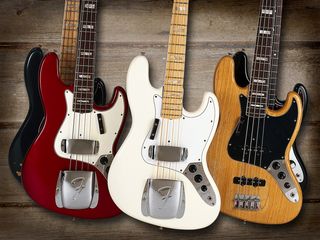
Fender Jazz Bass
ORIGINALLY PRODUCED: 1960-62
ORIGIN: USA
TYPE: Solidbody, passive 4-string
BODY: Ash, offset-waist twin cutaway
NECK: Maple, bolt-on, medium frets
SCALE LENGTH: 864mm (34-inch)
FINGERBOARD: Rosewood, dot inlays
HARDWARE: Chrome, 4-saddle raised-tail bridge
PICKUPS: Two single-coil, 8-poles apiece
CONTROLS: Volume & tone for each pickup from dual concentric controls
FEATURES: Controls and jack socket on chrome-plated ‘bell’ plate, two cover plates, muting rubber block stuck underneath bridge cover plate
FINISHES: Sunburst and custom colours with matching headstock
COMMENTS: This was the first version of the amazing Jazz Bass that was advertised initially as ‘the long awaited two pickup Precision’ however it was hardly that, in fact it was something quite unique.
Fender were already experimenting with offset bodies for the Jazzmaster but as horns gave basses much better instrument balance the Jazz Bass had them, thus giving it a look all of its own.
Although the dual concentric controls gave tremendous volume and tonal blending opportunities the components of the time were not up to the task and were notoriously unreliable, so were dropped in 1962 for the three-control version.
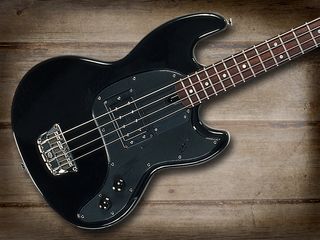
Wal Pro 1 & Pro 1E Bass
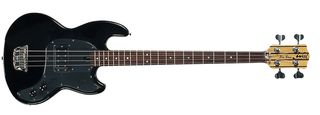
ORIGINALLY PRODUCED: 1978-82
ORIGIN: UK
TYPE: Solidbody, active (E) or passive 4-string
BODY: Ash three-piece, twin cutaway, other woods as ordered
NECK: Maple & mahogany laminated, bolt on, 21 medium frets
SCALE LENGTH: 864mm (34-inch)
FINGERBOARD: Rosewood with white pearl dot inlays
HARDWARE: Chrome, adjustable four-saddle bridge/tailpiece assembly
PICKUP: Wal humbucker with two rows of four pole pieces with a separate coil for each of the eight
CONTROLS: Volume, tone, active/passive slide switch
FEATURES: Modular FET active circuitry, body edge plate featured a regular jack or an alternative balanced line XLR for low impedance connection. This was popular with seventies session players but it also allowed the use of much longer leads for those stadium gigs! Schaller tuners with ‘crescent’ gear covers, large plastic scratchplate
FINISHES: Natural, black, colours to order
COMMENTS: The first British production line active bass the Pro Bass was offered with one or two pickups and a passive version was also offered, although relatively few of these were made. Mostly the bodies were ash with the best wood used for the natural finished models, as this was very much in fashion at the time.
If body wood appears unattractive then it was originally a coloured body that has been stripped by the owner! Early versions featured the ungainly ‘spade’ headstock, which was later reduced and reshaped. Passive models could be converted to the active E model if required by fitting the alternative ‘active’ scratchplate that included the battery compartment and the slide switch.
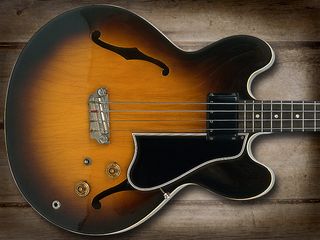
Gibson EB-2 Bass
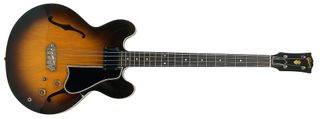
ORIGINALLY PRODUCED: 1958-61
ORIGIN: USA
TYPE: Archtop semi-hollowbody, 4-string
BODY: Maple faced 4-ply top, twin cutaway, bound with f-holes
NECK: Mahogany, glued-in, 20 jumbo frets
SCALE LENGTH: 775mm (30.5-inch)
FINGERBOARD: Rosewood with white dot inlays
HARDWARE: Chrome, 4-saddle bridge, Kluson rear facing ‘banjo style’ tuners with plastic keys, single saddle bridge/tailpiece
PICKUP: Single humbucker, black faced with screw type adjustable pole pieces initially to one end of the pickup then moved to the centre
CONTROLS: Volume, tone and baritone tone switch
FEATURES: Black laminated plastic floating scratchplate,
FINISHES: Natural and sunburst mostly although Gibson’s classic cherry red did appear occasionally
COMMENTS: Introduced as the bass version of Gibson’s popular ES-335 guitar the EB-2 has a narrow neck with a 38mm nut and substantial depth. Although semi-hollow the body construction features a large central core that makes it heavier than it looks and gives it a neat combination of solid and acoustic bass sounding elements.
The baritone switch appeared about 1959 and was originally a push button but soon became a regular switch. The banjo tuners disappeared during 1960 to be replaced with the more common sideways ‘elephant ears’ open gear design. The rather basic bridge/tailpiece offered little adjustment values and originally the strings were anchored over a foam strip to offer damping. Like all early basses they were supplied with tapewound strings so the bass had a plummy but substantial thud of a sound.
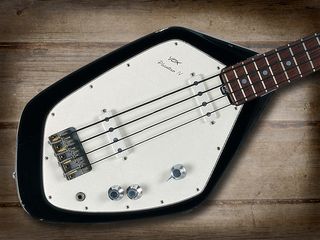
Vox Phantom IV Bass

PRODUCED: 1962–64 (UK) 1965-69 (Italy)
ORIGIN: UK & Italy
TYPE: Solid asymmetrical pentagonal body, 4-string
BODY: Sycamore
NECK: Sycamore (very early models) or maple, bolt-on, 20 medium frets
SCALE LENGTH: 864mm (34-inch)
FINGERBOARD: Rosewood or ebony with white dot inlays
HARDWARE: Chrome cover over 4-saddle raised tail bridge, open gear tuners
PICKUPS: Two single-coil units with 4 pole pieces and chrome surrounds initially then white plastic
CONTROLS: Volume, tone and three-position pickup selection lever switch
FEATURES: Capstan-style truss rod adjuster at body end of neck, most models had a pointless finger rest set near the neck, some headstocks matched body colour
FINISHES: Polyester Black or White although some other colours are known to exist
COMMENTS: It was president Tom Jennings who commissioned the London Design Centre to produce a unique body design for Vox in 1961 and the Phantom was born. Initially the bass version was built in the UK but production was soon sub contracted to EKO in Italy although, unlike today, these models sold at a higher price.
Amazingly when first introduced the Phantom sold for more than a Fender Precision in the UK! The Italian-built models also included a Gretsch style removable padded back cushion with pop-on studs.
Earliest versions had Phantom on the headstock not Vox and as much of the body was covered by a similarly shaped white scratchplate the colour was largely unimportant. The pickups were modelled on the original Fender P-Bass design and worked surprisingly well as a pair. Sadly the Phantom IV has atrocious balance but the good solid sound and unique appearance are still appealing.
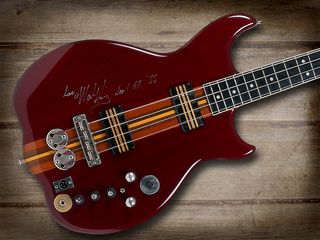
Jaydee Supernatural Classic Series 1 Bass
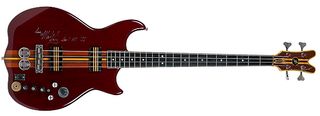
ORIGINALLY PRODUCED: 1984-current
ORIGIN: UK
TYPE: Solidbody, active/passive 4-string
BODY: Mahogany wings, laminated centre block, twin cutaway
NECK: Maple/walnut/mahogany laminate, glued-in, 21 hard nickel alloy frets
SCALE LENGTH: 864mm (34-inch)
FINGERBOARD: Ebony, bound, white dot inlays
HARDWARE: Chrome, 4-saddle bridge, brass nut, Schaller M4 tuners
PICKUPS: Custom wound hum-cancelling units (SN2000’s currently) with laminated polished hardwood cases
CONTROLS: Active/passive switch, volume & tone for passive mode, 4-position rotary pickup selector and three centre notched EQ rotaries
FEATURES: Strings are anchored in a pair of dual keyhole chrome discs
FINISHES: Natural satin
COMMENTS: Jaydee stands for John Diggins, the British luthier responsible for these high quality instruments. The laminated neck wood is mirrored at the centre of the body thus presenting a neck-through-body appearance.
Having a cannon as well as a jack socket on the bass was used as a means to connect directly into the PA. Stadium bands used this idea a lot during the seventies, as being low impedance the cable could be much longer than a regular jack to jack.
Whilst some Classics had dot markers others had a set of distinctive oval inlays. This particular bass belonged to Mark King and was signed and donated by him for a charity auction in 1988. We wonder where it is now...
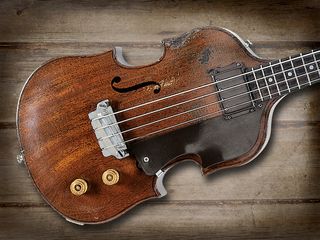
Gibson EB-1 Electric Bass

PRODUCED: 1953-58
ORIGIN: USA
TYPE: Solid violin shaped arched body, 4-string
BODY: Mahogany
NECK: Mahogany, set neck, 20 fine frets
SCALE LENGTH: 775mm (30.5-inch)
FINGERBOARD: Rosewood, pearl dot inlays
HARDWARE: Chrome bridge/tailpiece, single-saddle bridge, banjo style tuners with rear-facing knobs
PICKUPS: Single alnico magnetic pickup with brown Royalite cover
CONTROLS: Volume & tone
FEATURES: Telescopic endpin for upright playing
FINISHES: Natural brown lacquer with painted f-holes
COMMENTS: This was the first electric bass from Gibson hence the name. However it was rechristened the EB-1 after the introduction of the EB-0 in 1956. It was Gibson’s tradition of organising model numbers by their price that caused the EB-0 to undercut this designation because it was cheaper!
The EB-1 briefly resurfaced in 1970 with a few cosmetic changes but by 1972 it was gone again! With its violin shape and endpin it was definitely aimed at bridging the gap between an upright bass and a bass guitar. The earliest versions with a brown pickup cover had a huge single-coil unit inside that was actually mounted on its side. This gave it a cleaner and better-defined sound than the 1958 versions that were given a regular bass humbucker.
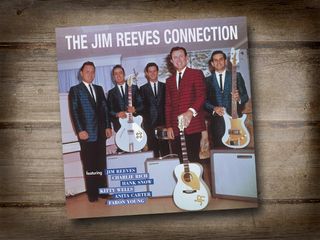
Rickenbacker 4000 Bass
PRODUCED: 1957–1984
ORIGIN: USA
TYPE: Flamboyant 'cresting wave' twin cutaway solidbody, 4-string
BODY: Maple wings stuck to mahogany neck-through core
NECK: Mahogany or walnut, through-neck, 20 medium frets
SCALE LENGTH: 851mm (33.5-inch)
FINGERBOARD: Rosewood, dot markers
HARDWARE: Nickel or chrome, bridge/tailpiece included a string damper assembly, Schaller BM nickel tuners
PICKUPS: Huge horseshoe magnet pickup featuring a distinctive gap in the wrist rest section where the magnets oppose each other
CONTROLS: Volume and tone, chrome plated or black 'flying saucer' knobs
FEATURES: Clear plastic bridge borders, clear plastic finger rest, gold back-painted clear plastic pickguard with alternative white available around 1958. When the 4001 appeared the scratchplate adopted that design, gold was dropped and later black was introduced
FINISHES: Mapleglo and old-style Fireglo (2-tone brown sunburst)
COMMENTS: Like Fender’s Precision Bass, Rickenbacker almost got it right first time with their visually startling 4000 model. It was the first bass to feature through-neck construction where the bridge pickup, neck and headstock were all on the same piece of wood so effectively maximising on resonance and sustain.
This mahogany centre core had maple ‘wings’ stuck to it to form the ‘cresting wave’ body shape named after the famous Japanese painting, and also used for the headstock. Designer Roger Rossmeisl had introduced this manufacturing technique on the Combo 400 guitar the previous year.
Earliest versions had a fixed modified bridge with a standard guitar string anchor leaving two slots unused. This was soon replaced by a movable bridge with string mute. Of all the early bass guitars, the 4000 was the closest to Fender’s 34-inch scale and also benefited by the more vibrant sound this length seems to magically produce.
Although it doesn’t possess the classic Rickenbacker growling sound that we know and love today, it gives a robust delivery that is still mighty appealing. The 4000FL fretless version was also available from 1960 but only as a special order.
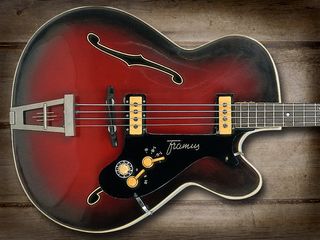
Framus Star Bass 5/150
4 out of 5
PRODUCED: 1959-68
ORIGIN: Bavaria
TYPE: Semi-acoustic body, 4-string
BODY: Mahogany top and back, maple sides, white binding, single cutaway, two f-holes
NECK: Maple, set neck, 20 medium frets
SCALE LENGTH: 775mm (30.5-inch)
FINGERBOARD: Rosewood, bound with white dot inlays
HARDWARE: Chrome tailpiece and scratchplate, guitar sized tuners with plastic keys
PICKUPS: Two four-pole pickups mounted on metal floating scratchplate
CONTROLS: Volume & tone, plus rotary pickup selection lever switch
FEATURES: Single-saddle rosewood bridge, separate heavy duty chrome plated tailpiece, painted headstock, lever style control knobs
FINISHES: Black Rose or Shaded Blonde
COMMENTS: In the 1950s when American instruments were almost impossible to get many British groups used Framus basses and the first bass superstar, Jet Harris, used his on many of the early Drifters and Shadows tracks.
The models he used, however, had the sharper edged Florentine cutaway with two volumes and two tone controls set into the scratchplate. The more rounded Venetian cutaway seen here was championed by Bill Wyman of The Rolling Stones.
He also used the smaller bodied 5/149 single pickup version too. Later versions saw the scratchplate dispensed with and the pickups fitted to the body as well as super finishes but as the bass progressed it lost much of its appeal. These days parent company Warwick do a pretty faithful reproduction of this as the Framus Vintage 5/150 Star Bass.
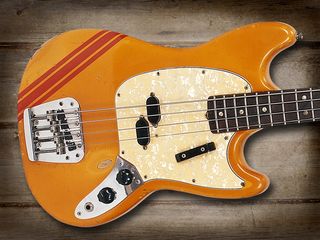
Fender Mustang Bass

PRODUCED: 1966-81 (Reissued by Fender Japan in 2002)
ORIGIN: USA
TYPE: Solidbody, 4-string
BODY: Poplar (alder later)
NECK: Maple, bolt-on, 19 medium frets
SCALE LENGTH: 762mm (30-inch)
FINGERBOARD: Rosewood with pearl dot inlays, optional maple board available from 1975
HARDWARE: Chrome bridge plate with raised and folded tail, four saddles, separate chrome control plate, open gear tuners initially with oval keys
PICKUPS: Down-sized split coil with hidden pole pieces
CONTROLS: Volume and tone with Jazz-style knobs
FEATURES: Through-body stringing and individual string dampers
FINISHES: Plain colours, optional competition colours with matching headstock and GT stripes during 1968-72 period
COMMENTS: Following hot on the heels of the Mustang guitar, being launched as a ‘junior’ instrument and ‘one for the ladies’ gave the Mustang bass a bit of a shaky start. This was Fender’s first short scale 4-string bass and was aimed at the guitarist who sometimes switched to bass.
This was the last bass designed by Leo Fender following the company buy-out by CBS and fell in line with his mix and match ethos by making use of the jigs initially designed for the Musicmaster guitar. Interestingly this bridge and damper assembly was the earliest example of the design favoured by Leo for his first Music Man StingRay basses that would appear in the seventies.
The rear body scoop is disproportionately large and the finger rest moved above the strings in the seventies to become a thumb rest and for a while some had two! This particular Mustang Bass includes the rarely seen oval tuning keys that were soon phased out for the regular shamrocks or elephant ears as they were lovingly known.
Lots of colour variations and even an Antigua finish with matching scratchplate around 1977-79. Regular users include Alan Lancaster of Status Quo, Tina Weymouth of Talking Heads, Bill Wyman had one with The Rolling Stones for a while and Roger Glover used one on Deep Purple’s Fireball album.
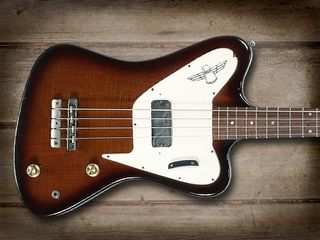
Gibson Thunderbird IV Bass - Non Reverse

PRODUCED: 1965-69
ORIGIN: USA
TYPE: Solid body, 4-string
BODY: Mahogany slab with curved edges
NECK: Mahogany, set neck, 20 medium frets
SCALE LENGTH: 876mm (34.35-inch)
FINGERBOARD: Rosewood with white dot inlays
HARDWARE: Chrome plated tune-o-matic bridge, separate tailpiece, open gear tuners
PICKUPS: Two chrome-plated humbuckers
CONTROLS: 2 volume controls and one tone
FEATURES: Chrome covers, large white laminated scratchplate with Thunderbird motif and finger grip
FINISHES: Sunburst or Gibson custom colours with matching headstocks
COMMENTS: Introduced in 1963 as the bass version of the Firebird guitar, the original Thunderbird bass featured an outrageous ‘reverse body’ design. It was met with a degree of trepidation and its reception was at best luke warm.
In an attempt to reinvent what was actually a fine bass the non-reverse design was introduced in the 1965 Gibson catalogue although instrument production began in earnest in 1966. The neck through body construction was abandoned so the raised centre section as seen on the original Thunderbird Bass disappeared thus allowing for the big distinctive scratchplate.
Before the Thunderbirds all Gibson basses were short scale but these were full scale and were offered with one (Thunderbird II) or two (Thunderbird IV) pickups. The headstock was set back at an angle for secure string slotting into the nut.
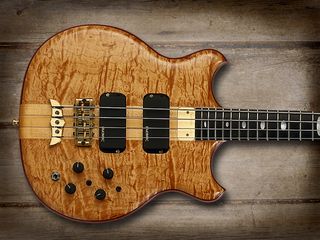
Alembic Stanley Clarke 'Small Standard' Bass
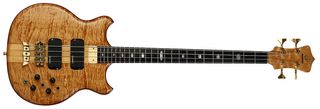
PRODUCED: 1988-present
ORIGIN: USA
TYPE: Solid body, 4-string
BODY: Mahogany wings with quilted maple top
NECK: Laminated three maple/two walnut pinstripes neck-through body, 24 medium frets
SCALE LENGTH: 864mm (34-inch)
FINGERBOARD: Ebony with oval pearloid inlays
HARDWARE: Bass multi-adjustable bridge, sealed gear tuners
PICKUPS: Pair of Alembic AXY4 hum-cancelling units, active circuitry and EQ
CONTROLS: Volume, two tone filters, pan/blend control, two Q switches
FEATURES: Brass nut, solid brass ‘Bird’ tailpiece
FINISHES: High gloss polyester with satin neck
COMMENTS: This was by no means the first Stanley Clarke model as it was built in 1994 but it’s certainly one of the most striking basses that Alembic have ever built. In spite of its 'Small Standard' tag it’s actually a full-scale bass whereas most of its predecessors were a keener 30.75-inch length.
The symmetrical body here holds much of its appeal, along with its relatively modest proportions. The ultimate in adjustability the Stanley Clarke comes with a tool kit and once the pickups and bridge are set as required they can be locked into place.
The active electronics give this model a mighty boost in performance and punch thus taking the muscle out of playing. With a headstock of this size poor balance is inevitable but it’s a minor annoyance and in spite of its comparatively high price, in Alembic terms this particular model was a lot cheaper than most at the time of production.
Initailly launched with this symmetrical body the later versions saw a slightly larger upper body horn with the strap button placed there for improved balance. In spite of their strict no endorsement policy, after thirty years of working together Alembic presented Stanley with a specially inlaid instrument.
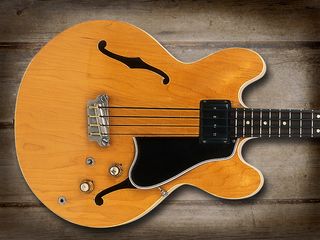
Epiphone Rivoli Bass

PRODUCED: 1959-62, 1963-69
ORIGIN: USA
TYPE: Semihollow body, twin rounded cutaway, 4-string
BODY: Maple with ivoroid binding
NECK: Mahogany, glued-in, 20 medium frets
SCALE LENGTH: 775mm (30.5-inch)
FINGERBOARD: Rosewood, white dot inlays
HARDWARE: Chrome cover over bridge/tailpiece, 4-saddle bridge, open gear tuners
PICKUPS: Two single-coil units with white plastic surrounds
CONTROLS: Volume, tone plus bass boost switch
FEATURES: Solid centre section to body, f-holes
FINISHES: Natural or three-tone sunburst
COMMENTS: When Gibson bought out the Epiphone Company in 1957 it allowed the company to bypass its rather foolish decision to only supply Gibson instruments to ‘vetted’ music stores in each town. Epiphone allowed them to supply many more.
The EB-2 bass was doing well so it made sense to bring out the virtually identical Epiphone Rivoli just a year later using the same parts. Like the EB-2 the first models had banjo-style tuners with plastic pegs and the pickup resided under a black plastic cover. Both were changed in due course, as was the bridge, which was upgraded to a more adjustable unit.
The boost switch varied from push-on/push-off type to single throw. It was dropped in 1962 but found favour in the UK during the British beat boom so was quickly put back into production. Limited in sound options and heavier than it looks, but a truly great instrument.
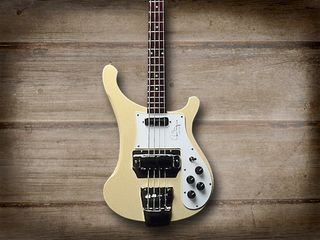
Rickenbacker 4001 CS
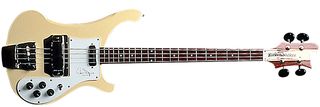
PRODUCED: 1991-2000
ORIGIN: USA
TYPE: Solidbody, twin cutaway, 4-string
BODY: Eastern rock maple wings
NECK: Maple neck-through, 20 fine frets
SCALE LENGTH: 851mm (33.5-inch)
FINGERBOARD: Vermillion, white pearl dot inlays
HARDWARE: Chromed upper magnet section of pickup, bridge/tailpiece, open gear tuners
PICKUPS: Single coil horseshoe unit and smaller ‘toast rack’ unit at neck position
CONTROLS: 2 Volume & 2 tone, 3-way pickup selector switch
FEATURES: Made in the image of Chris Squire’s own bass, white scratchplate with his signature on it
FINISHES: Cream lacquer
COMMENTS: Over the course of time the Rickenbacker 4001 lost much of its appeal following what are tantamount to poor design choices. It all centres on the loss of the horseshoe magnet with its distinctive ‘split’ in the chrome ‘cover’ above, which of course is actually part of the pickup itself.
Chris Squire’s 4001S bass was originally Fireglo finish but he stripped it on more than one occasion, so much so that the body ended up with very unique dimensions. But it always sounded fantastic on Yes albums and shows so the Signature CS model was much anticipated.
It is a stunning bass indeed and offers an opportunity to own something newer that is a faithful reproduction of the original but with the Squire dimensions. Chris’ comment: "We did everything to duplicate my bass from the size, wood, finish, neck profile and even the windings and the mass of the metal on the pickup. It sounds really great but mine still has that certain something extra."
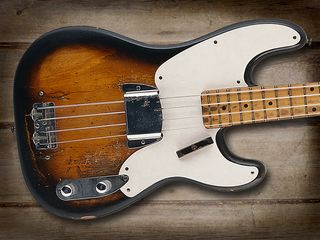
Fender Transition P-Bass

PRODUCED: 1954-1957
ORIGIN: USA
TYPE: Solidbody, twin cutaway, 4-string
BODY: Ash mainly but alder also used
NECK: Maple, bolt-on, 20 medium frets
SCALE LENGTH: 864mm (34-inch)
FINGERBOARD: Maple, black dot inlays
HARDWARE: Chrome covers over bridge/tailpiece and pickup, twin brass-saddle bridge, reverse action open gear tuners
PICKUP: One singlecoil
CONTROLS: Volume & Tone on separate plate
FEATURES: Large scratchplate, through-body stringing, Telecaster styled headstock
FINISHES: 2-tone Sunburst, Blonde & Custom Colours
COMMENTS: The Fender Transition P-Bass earned its name as it represented the first round of updates but didn’t get quite as far as the major overhaul in 1957.
Here the slab body was given contouring in line with the newly released Stratocaster and Sunburst became an option to the regular blonde finish with custom colour choices added in 1956. An alternative white scratchplate was also introduced that still covered most of the body and that all-important Telecaster styled headstock remained.
Sting has a couple of these from 1955 and 1957 although apparently fitted with Seymour Duncan Custom Shop Basslines Stacked single-coil pickups that help overcome some of the original pickups’ shortcomings. The later model has an alder body.
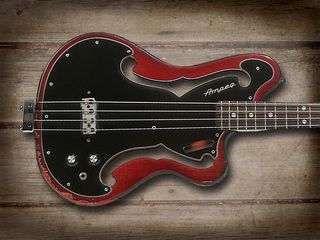
Ampeg AEB-1

PRODUCED: 1966 - 1969
ORIGIN: USA
TYPE: Solid body, smooth cutaway, 4-string
BODY: Maple sections glued to plywood with through-cut f-holes
NECK: Maple, bolt-on, 20 medium plus zero fret
SCALE LENGTH: 876mm (34.5-inch)
FINGERBOARD: Rosewood or Ebony with white dot inlays (Also rare non-specified blonde fretboard with black dots)
HARDWARE: Chrome tailpiece, open gear tuners, 4-saddle bridge under chrome cover
PICKUPS: Hidden ‘mysterious’ pickup under bridge
CONTROLS: Volume & Tone (Volume has ‘pull to kill’ switch)
FEATURES: Aluminium nut, Scrolled open slot headstock with side mounted/rear facing tuners, Sunburst finish to back of neck
FINISHES: Cherry Red, Burnished Tones (Sunburst) or White
COMMENTS: The AEB-1 bass guitar is a curious design indeed with hardly any body visible as it had two large f-holes cut right through and a huge scratchplate that covered most of the rest.
The scrolled headstock with side-mounted tuners was similar to their upright Baby Bass and the AEB-1 also made use of the same ‘mysterious’ pickup design. This was effectively a contact mic using a Silectron Steel diaphragm to transfer the string vibrations to the two magnetic coils set beneath. Actually it’s a neat idea as it allows the use of non-magnetic (nylon or gut) strings.
The bridge has individual saddles and players often exposed it by removing the chrome bridge cover. Just Volume and Tone controls are fitted however the Volume had a switch incorporated that you could ‘Pull to Kill’ and knock out the Volume instantly.
It has a deep thud of a sound but is very penetrating. It’s a bit unwieldy to play as the scroll makes it rather top heavy and the tailpiece extends beyond the body edge.
The serial number is stamped into the back of this tailpiece. Some instruments were shipped with a bound fingerboard and the AUB-1 Fretless version was also available and notably used by Boz Burrell with King Crimson and Bad Company.
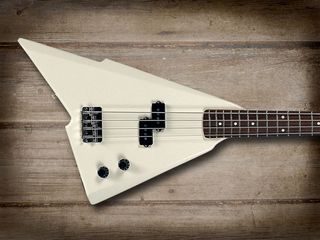
Squier Katana Bass

PRODUCED: 1985 - 1986
ORIGIN: Japan
TYPE: Solid body, Asymmetrical V-shape, 4-string
BODY: Alder
NECK: Maple, bolt-on, 20 medium frets
SCALE LENGTH: 813mm (32-inch)
FINGERBOARD: Rosewood, white dot inlays
HARDWARE: Chrome plated raised-tail bridge, regular open gear bass tuners
PICKUPS: Classic split-coil unit
CONTROLS: Volume and tone
FEATURES: The pointed headstock features an angular Squier logo atop a golden sword with ‘Made In Japan’ printed on it. Underneath is a minute ‘by Fender’ decal. Jack socket on body edge, strap button on neckplate.
FINISHES: Black and Olympic White, plus custom colours
COMMENTS: Although originally conceived as the ‘affordable’ line product of Fender, there have still been a few cool Squier ‘originals’ that have adapted regular parts to produce something quite special.
The Katana is a case in point and although essentially a P-Bass in a stunted V-shaped design, it’s still a striking instrument. Named after Japan’s traditional Samurai sword, the headstock is obviously a sliced-down Precision but works well for this supersonic design essentially aimed at the metal-heads of the time.
The chamfering and the upper step to the body added much visual appeal, as do the amplifier style control knobs. Balance is not great but the sound from these basses is generally good, although the lack of headstock mass does affect sustain.
The Katana was incredibly cheap at the time so you got a lot of bang for your buck. Very short-lived indeed, but quite collectable now.
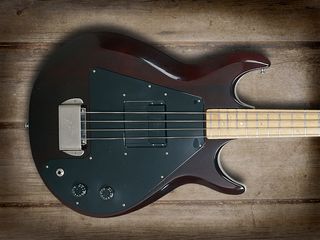
Gibson Grabber G-1 Bass
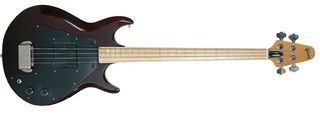
PRODUCED: 1973 - 1982
ORIGIN: USA
TYPE: Solid body, offset double cutaway, 4-string
BODY: Solid maple on earliest models then Alder
NECK: Maple, bolt-on, 20 medium frets
SCALE LENGTH: 876mm (34½ -inch)
FINGERBOARD: Maple, pearl dot inlays
HARDWARE: Chrome Tune-O-Matic Bridge with cover, regular open gear bass tuners
PICKUP: Gibson movable unit
CONTROLS: Volume & Tone
FEATURES: A Flying-V styled headstock in natural or black finish, Gibson Made In USA stamped on the neckplate, Black or Tortoiseshell scratchplate
FINISHES: Natural, Natural Satin, Natural Maple Gloss, Ebony, Wine Red, Black, White, Walnut and candy Apple Red
COMMENTS: The Grabber was the first bolt-on neck bass design by Gibson and quite a heavy bass to use.
The sliding pickup was seen as a step forward and it did offer some extra tonal qualities. It was fairly limited in movement and even in the extreme positions it was still essentially a centre location, although there was a discernable difference in the attack.
It had a good solid sound though and soon became Gibson’s entry-level bass. Natural Satin and Black were the most popular finishes with White and Walnut being the most rare. Candy Apple Red appeared briefly in the 1980s.
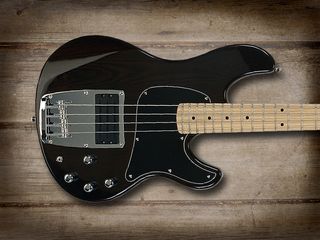
Ibanez ATK 300 Bass

PRODUCED: 1995 - 1999
ORIGIN: Japan
TYPE: Solid body, twin cutaway, Active 4-string
BODY: Light Ash
NECK: Maple 3-piece, bolt-on, 22 jumbo frets
SCALE LENGTH: 864mm (34-inch)
FINGERBOARD: Maple, black dot inlays
HARDWARE: Chrome ATK Custom Surround fixed raised tail bridge, open gear ‘Elephant Ears’ tuners
PICKUPS: Ibanez Triple Coil featuring dummy hum-cancelling coil
CONTROLS: Volume, Treble, Middle & Bass (all cut/boost), Pickup Character Switch
FEATURES: Two aside tuners, back plate in two parts for easier battery replacement
FINISHES: Solid Black, Natural & Sunburst
COMMENTS: Although sadly short lived the ATK was a fine workmanlike bass trying to muscle in on the Music Man action. It employs a relatively traditional look but the Custom bridge/pickup surround gives it an air of individuality.
With a 3-band active EQ the sounds generated are pretty expansive but even more so thanks to the Character mini switch that offers Attack, Bright and Traditional settings. This gives it something rather special, particularly when turned up to produce great growl and barking deliveries.
It was also available as the ATK305, which is the 5-string version, or as a regular 4-string with passive circuitry at a lower price. Although this may have been tempting at the time the active version is the one to get as it offers much greater tonal range and attack.
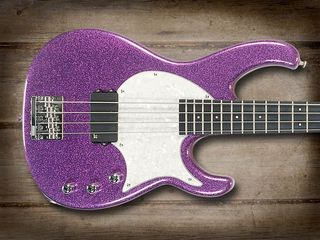
Modulus Graphite Flea Bass (FB4)

PRODUCED: 1997 – Present
ORIGIN: USA
TYPE: Solidbody, twin cutaway, 4-string
BODY: Alder
NECK: Carbon Graphite, bolt-on, 22 medium frets
SCALE LENGTH: 864mm (34 inches)
FINGERBOARD: Phenolic, small white dot inlays
HARDWARE: Chrome plated Gotoh raised-tail bridge, Modulus sealed gear tuners
PICKUPS: Lane Poor MMG, Bartolini NTBT active EQ
CONTROLS: Volume, Treble cut/boost & Bass cut/boost
FEATURES: Headstock colour matches the body, white or black three-ply pearloid scratchplate
FINISHES: Semi-gloss in Red, White, Black or Grey. Metalflake in Purple, Blue, Silver and Gold
COMMENTS: This was one of the earliest basses to be connected to Flea but there have been many since including those bearing his own name.
Our example is fitted with a Lane Poor pickup but other units and corresponding circuitry were also offered including Bartolini and the Basslines MM. The neck is one of the smoothest ever, thanks to the carbon content and the nut was made from this too.
The Flea is appropriately fast and funky and a true slappers delight, with more than enough output to shred your clothes.
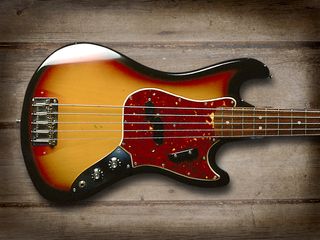
Fender Bass V

PRODUCED: 1965 - 1970
ORIGIN: USA
TYPE: Twin cutaway solid body, 4-string
BODY: Ash, elongated shape
NECK: Maple, bolt-on, 15 medium frets
SCALE LENGTH: 864mm (34-inch)
FINGERBOARD: Rosewood or maple with pearl dots (blocks later)
HARDWARE: Chrome raised tail bridge, bell plate and two cover plates with ‘F’ on bridge plate
PICKUPS: Single split coil with smooth top, unequal halves
CONTROLS: Volume & Tone with Fender ‘amp-style’ skirted control knobs
FEATURES: White or Tortoiseshell scratchplate, thumb rest, 5-saddle bridge with through-body stringing
FINISHES: 3-tone Sunburst and solid custom colours
COMMENTS: Whether it was due to the acceptance of the Bass VI by the bass playing community we can’t say but the reasoning behind Fender’s Bass V is still something of a mystery. It’s considered by many to be the worst Fender bass design ever and adding a high C string, rather than extending the bass range below, is hard to understand but obviously the performance restrictions of bass amplification of that time must have played a significant part.
Although it had a slim elongated body and a downsized neck with fewer frets, it still achieved a full 34-inch scale length. Initially the neck was unbound but around 1966 it became bound with block markers. A year later a maple fingerboard option was introduced. The extended headstock makes it ungainly so its visual appeal is virtually zero, it’s neither attractive nor sexy and both are essential elements of any instrument.
However, it did allow easy high note access across the board rather than up the neck and it actually sounds like a Fender bass so no complaints there. But even with John Paul Jones championing the instrument during his Led Zeppelin days the Fender V failed to gain popularity.
Nowadays it has become highly collectable and is certainly a classic instrument so justly deserves its moment of glory in our cool and classic gallery.
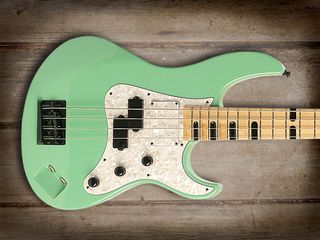
Yamaha Attitude Limited II Bass

PRODUCED: 1994 - Present
ORIGIN: Japan
TYPE: Twin cutaway solid body, Stereo 4-string
BODY: Alder
NECK: Maple, bolt-on, 21 medium frets
SCALE LENGTH: 864mm (34-inches)
FINGERBOARD: Maple with a gloss finish, offset black slot inlays
HARDWARE: Black Anodised tuners and raised tail bridge
PICKUPS: Camouflaged Woofer & Split Coil
CONTROLS: DiMarzzio Woofer Volume, Woofer Tone with switch, singlecoil Volume with switch to activate mono circuit.
FEATURES: Stereo circuit, but can be switched to mono; fingerboard half scalloped for top five frets, Hipshot D-Tuner
FINISHES: Sea Foam Green with Crushed Ice scratchplate or Black
COMMENTS: The Attitude Limited and this Attitude Limited II Bass were both developed for, and with the help of, bassmeister Billy Sheehan. Obviously it was based on a Fender, but with very specific design changes such as the slab body and the stereo circuitry. To operate this in true stereo required two separate amplifiers, but used in this way the bass is simply awesome in sound.
The electronics are consequently a bit strange and incorporates switching on the controls, but at least this also allows for mono operation. The two jack sockets set into a slanted recess in the body surface and curiously the Woofer pickup (Yamaha’s word) is semi-hidden beneath a cover of the same material as the scratchplate.
In addition, the five uppermost frets are scalloped to assist in the bending of the top two strings, something that Billy was fond of doing. To give this more general appeal Yamaha also made it available as the Attitude Special Bass with regular mono circuitry.
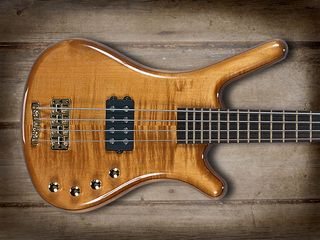
Warwick Corvette FNA Bass

PRODUCED: 1999 only
ORIGIN: Germany
TYPE: Twin cutaway solid body, 4-string
BODY: Ash with a flame maple top over a walnut veneer
NECK: Wenge, bolt-on, 24 medium frets
SCALE LENGTH: 864mm (34-inch)
FINGERBOARD: Wenge
HARDWARE: Gold-plated fully adjustable bridge and separate tailpiece
PICKUPS: Single MEC Humbucker
CONTROLS: Volume/Slap Contour Switch, Treble, Middle, Bass
FEATURES: The body has an extra contoured ‘slice’ at the heel for improved top fret access,
FINISHES: Honey Violin High Gloss, Natural and Coloured Oil Finishes
COMMENTS: This was a short-lived revamp of Warwick’s Altus bass and actually the FNA stands for ‘Formally Known as Altus’, albeit with a slight spelling mistake!
It was the first Warwick bass to make use of a Music Man styled MEC humbucking pickup and it worked extremely well. The lack of scratchplate allows this beautiful Honey Violin finish and the gold hardware to positively glow with sophistication.
The distinctive Warwick multi adjustable bridge and separate tailpiece are set below the body surface for a minimalistic presentation and the walnut veneer beneath the maple top gives a ‘coach line’ effect on the body.
The sound, although similar to an Ernie Ball Music Man StingRay, still retains that distinctive Warwick quality and feel. It was dropped in favour of the FNA Jazzman with two pickups but remains a beautiful bass, light in weight and with a great range of sounds.
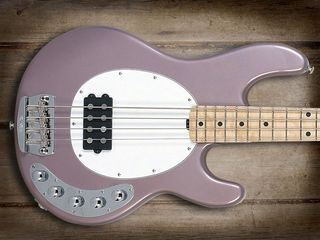
Ernie Ball Music Man Piezo StingRay Bass

PRODUCED: 2000 - Current
ORIGIN: USA
TYPE: Twin cutaway solid body, 4-string, active
BODY: Selected hardwoods
NECK: Maple, bolt-on, 21 medium frets
SCALE LENGTH: 864mm (34-inch)
FINGERBOARD: Maple
HARDWARE: Chrome Music Man raised tail bridge, crescent moon control plate and short shank ‘shamrock’ open gear tuners
PICKUPS: Music Man eight-pole humbucker & Piezo-loaded bridge
CONTROLS: Volume, Blend, Treble, Middle & Bass
FEATURES: Classic StingRay looks with additional electronics, Schaller BM tuners with tapered string posts
FINISHES: Pearl Lavender high gloss polyester (as pictured) and all standard colours at same price, Vintage and Natural finishes cost extra
COMMENTS: The original StingRay design is definitely a thing of beauty so how do you install a second pickup to increase the tonal range without compromising that simplicity - fit Piezo transducers under the bridge saddles!
An additional cover on the back of the body reveals a cavity beneath the bridge where the Piezo circuitry and trimming pots can be accessed. The bridge is the shorter based design that was introduced when the individual string dampers were dropped. The control plate handles the five controls rather neatly but although the additional pickup gives this an increased range of sounds the two sound sources are too close together to produce any real ‘hollow’ sounds.
However, there is something of a sweet spot here thanks to the surprisingly warm element coming from the Piezo circuitry. Left handed and fretless models sold at the same price and the sheer range of colours available is quite frankly amazing with some having matching headstock finishes too.
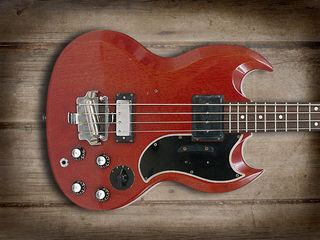
Gibson EB-3 Bass

PRODUCED: Initially 1961 - 1979
ORIGIN: USA
TYPE: SG shaped twin cutaway solid body with bevelled edge, 4-string
BODY: Mahogany
NECK: Mahogany set neck, 20 medium frets
SCALE LENGTH: 775mm (30.5-inch)
FINGERBOARD: Rosewood, pearl dot inlays
HARDWARE: Nickel-plated, single bar-bridge initially, Kluson open gear tuners
PICKUPS: Large humbucker and mini humbucker
CONTROLS: Two Volume and two Tone plus a four-position rotary control
FEATURES: Laminated black scratchplate, finger rest, chromed metal wrist rest, Crown inlay on black-faced headstock
FINISHES: Cherry Red, Ebony (rare), Natural (introduced in 1971), White (introduced in 1976)
COMMENTS: When the Gibson EB-0 was revamped with the new SG styling, the EB-3 was also introduced sporting an additional pickup, another volume and tone control plus a four-position rotary switch that offered instant tonal variation.
This gave the bass far more sound definition than any other Gibson at the time and it soon became their most popular model. As a consequence it also became their most modified and remodelled bass ever and it’s still going on today.
The initial plastic cover on the neck pickup was changed to metal in 1962. The single saddle bridge/tailpiece was soon upgraded to individual saddles and the earliest versions included a pull lever damper. Many different bridges have actually been used, metal wrist rests have come and gone, the neck pickup was relocated more centrally for a while during the seventies, 19 and 21 frets came and went, as did the inbuilt Fuzztone option.
During the period 1969 - 1972 bound rosewood fingerboards and a slotted (classical style) headstock were introduced. The EB-3L (1971-1973) offered a longer (34.5-inch) scale length and was available in standard cherry finish or white.
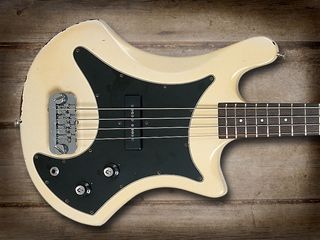
Guild B-301 Bass

PRODUCED: 1977 - 1981
ORIGIN: USA
TYPE: Twin cutaway offset solid body, 4-string
BODY: Mahogany
NECK: Mahogany set-neck with maple stringer at back, 20 heavy frets
SCALE LENGTH: 864mm (34-inch)
FINGERBOARD: Rosewood, white pearl dot inlays
HARDWARE: Chrome, brass bridge, two-a-side Schaller open gear tuners
PICKUP: Single-coil DiMarzio
CONTROLS: Volume & Tone
FEATURES: Multi-adjustable bridge, fretted or fretless
FINISHES: Natural, Black, Red and White
COMMENTS: One of the most collectable Guild basses ever and consequently quite often found today with different pickups fitted. The uniquely shaped body is well proportioned and the bass is relatively light in weight in spite of having both the body and neck made in mahogany. The black-faced headstock features an inlaid pearl Chesterfield (crown and pillar) logo and is tilted back for good string anchorage through the nut.
The DiMarzio pickup sits slightly off-centre towards the bridge and this gives it a good solid sound. The Fender like black-skirted knobs have dimpled silver tops with ‘G shield’ embossed logo and along with the jack socket all sit upon the black laminated scratchplate. The chrome plated solid brass bridge is adjustable so allows for altering string spacing and the B-301 is well known for its excellent sustain, as is the twin pickup version the B-302.
It was also available as a fretless and is definitely a bass to try if you get the opportunity.
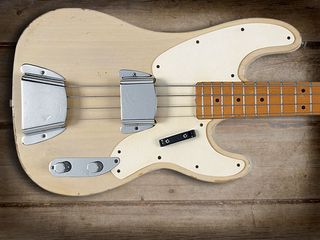
Fender Telecaster Bass Series 1

PRODUCED: Second Version 1968-1972
ORIGIN: USA
TYPE: Twin cutaway solid slab body, 4-string
BODY: Ash
NECK: Single piece hard rock Maple, bolt-on, 20 medium nickel-silver frets
SCALE LENGTH: 864mm (34-inch)
FINGERBOARD: Maple, black dot inlays
HARDWARE: Chrome pickup and bridge cover plates, separate control plate, two saddle bridge, open gear tuners
PICKUPS: Fender single-coil
CONTROLS: Volume & Tone
FEATURES: Telecaster shaped headstock, finger rest, through body stringing
FINISHES: Translucent Blonde, Sunburst & Custom Colours
COMMENTS: In 1968 Fender acknowledged an increase in demand and released the Telecaster Bass (so called because of the distinctive Tele-Style headstock). It was pretty much a replica of the original Precision Bass of 1951 using existing ‘left over’ stock so what is particularly significant is that these instruments were essentially the very first reissues from the company.
Curiously many of these also sported the distinctive oval (paddle) tuners that were previously only ever seen on a few Jazz basses and usually those with custom finishes. The scratchplate had extra securing screws as the original plates were inclined to warp over a period of time and the finger rest was fixed with two screws to prevent the annoying twirling of the single screwed original. The very first of these used a Telecaster guitar decal on the headstock with ‘BASS’ added and some had a maple capped neck so there was no skunk stripe at the back.
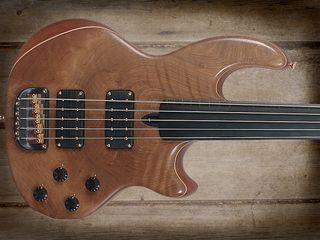
Wal Custom Mach II - Gold Plated Fretless 5-string

PRODUCED: 1986 - Current
ORIGIN: UK
TYPE: Twin cutaway solid body, 4-string
BODY: Varies with exotic wood facings
NECK: Varies, bolt-on, 24 medium frets
SCALE LENGTH: 864mm (34-inch)
FINGERBOARD: Ebony with short fret-lines beneath the bottom B string only
HARDWARE: Gold plated or chrome if requested
PICKUPS: Hand made humbuckers with two pickups per string that are wound in opposite directions
CONTROLS: Volume (with pick attack), Balance, & individual Tone controls for each pickup with boost activation
FEATURES: Active electronics from an internal preamp, 9-volt power pack, jack and balance XLR sockets, special design string tree
FINISHES: Natural satin, polished wood
COMMENTS: The Custom Mach II was the first deviation from the Wal production line. It features a slightly larger body than the Pro with an elongated upper horn for improved balance specifically designed for this, their first, five-string model. It has a pair of custom designed Wal humbucking pickups, new bridge and headstock designs and a two-octave fingerboard. The on board active electronics were sophisticated for the time and, more importantly, highly reliable. The tone controls are actually low pass filters and when the controls are pulled up you get a boost to the harmonic frequencies. The Volume control also has a pull switch function to introduce a high frequency element termed pick attack. The battery is housed within the control cavity along with the circuit boards and there are trim pots for all but the balance control. There’s enough adjustment available here to significantly alter the sound of the bass giving many Wal basses their own distinctive qualities. Session players love the DI socket but a jack plug still needs to be inserted in order to switch on the preamp. As with many relatively small manufacturers dates and material spec is hard to verify as records are sparse and many Wal basses were made to customer’s requirements hence Custom in the title. Paduak and hornbeam necks were often requested and quilted maple or American Black Walnut facings were very popular in the eighties. Fretless versions usually had ebony boards. The Mach II has also become known as the Mark II and this new design proved so popular that a four-string version soon followed.
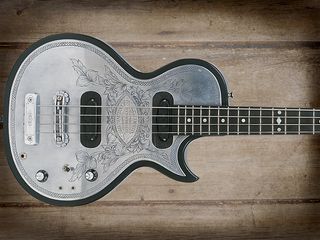
Zemaitis M/F Custom Bass

PRODUCED: Circa 1972 - Current
ORIGIN: UK
TYPE: Single cutaway body, 4-string
BODY: Mahogany
NECK: Mahogany, glued-in, 22 medium frets
SCALE LENGTH: 864mm (34-inch)
FINGERBOARD: Ebony with pearl block inlays
HARDWARE: Hand carved duralumin bridge and separate tailpiece, Gotoh tuners
PICKUPS: Zemaitis made original P-Bass style.
CONTROLS: Volume, Tone & Pickup Select switch, plus two 3-way micro switches for phase and tone
FEATURES: Slab body with metal top plate
FINISHES: Black Satin with brushed and engraved alloy front
By its very name the Zemaitis Custom Bass varies according to the wants of the purchaser, as do many of the guitars bearing his name.
Tony McPhee of the Groundhogs bought the first M/F (metal front) solid guitar as the metal plate proved extra shielding to reduce unwanted stage interference. When Ronnie Lane and Ronnie Wood of the Faces originally called into the Zemaitis workshop Tony had no idea who they were but they returned regularly and bought guitars and basses and helped to popularise the model.
Mostly the designs are based on the Les Paul shape, but tops are usually either like this highly patterned aluminium (a striking look achieved using a gun engraver) or featuring a multi-pearl mosaic.
Heavy in weight and heavy on the pocket, Zemaitis basses tend to make use of Seymour Duncan split coil and J-type units. Tony Zemaitis Jr continues the company since his father sadly passed away in 2002.
Our picture shows a fabulous 1992 Custom with original straight P-Bass style single coil pickups as commissioned by Bob Daisley, and our thanks go to him for allowing us to share this rare example.
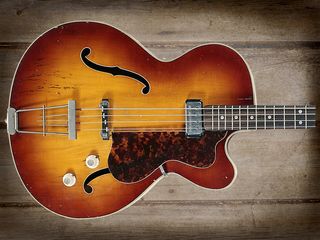
Hofner Senator
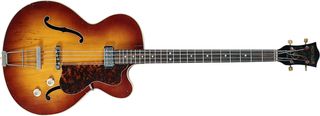
PRODUCED: 1959 – Early Seventies
ORIGIN: Germany
TYPE: Single cutaway semi hollow archtop, 4-string
BODY: Maple Bound body and f holes, German spruce top
NECK: 3-piece maple ‘Slenda-nek’, glued in, 22 jumbo frets plus zero fret
SCALE LENGTH: 813mm (32-inch)
FINGERBOARD: Rosewood with pearl dot inlays
HARDWARE: Chrome trapeze tailpiece, guitar sized tuners
PICKUP: Nova-Sonic double pole, double coil unit (Staple)
CONTROLS: Volume & Tone
FEATURES: floating scratchplate, adjustable rosewood bridge with fret wire saddles, distinctive Hofner three-ply nut
FINISHES: Brunette Sunburst, Cherryburst,
COMMENTS:Originally produced as the 500/3 in the late fifties, it took Hofner's London-based distributor, Selmer's of Charing Cross Road, to introduce model names and thus baptise this f-holed beauty.
When the standard control plate was dropped in favour of surface mounted controls and thebody depth was reduced, it was given the name Senator, bringing it in line with the guitar. Most of Hofner's instruments were subjected to many design tweaks in order to keep them as up to date as possible.
Although similar in design to the Club Bass it had a bigger body, and the Nova-Sonic pickup offers the screw and staple design that in hindsight was one of the best pickups Hofner ever produced.
It gave a well-balanced and rich tone, plus plenty of that famous Hofner bass thump that could really shake the room. After constant use, the scratchplate tended to get loose due to the constant vibrations, so many players removed them.
The treble clef on the headstock dates our example as pre-1964, as then the dagger like shape replaced it. Additionally, if you wanted to buy a plush-lined case, it would set you back more than a third of the price of the bass. Nice.
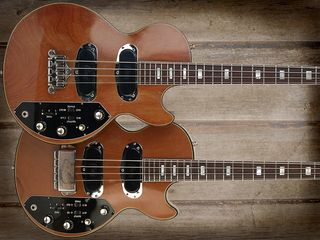
Gibson Les Paul Triumph

PRODUCED: 1972 – 1979/80
ORIGIN: USA
TYPE: Single cutaway solid body, 4-string, passive
BODY: Bound 2-piece Honduras Mahogany, carved top
NECK: 3-piece mahogany, set neck, 24 medium frets
SCALE LENGTH: 775mm (30.5-inch)
FINGERBOARD: Bound Rosewood with pearl block inlays
HARDWARE: Chrome, adjustable 4-saddle bridge/tailpiece, bridge cover plate, pickup surrounds
PICKUPS: Pair of Gibson black covered low impedance humbucking units
CONTROLS: Volume, Bass, Treble, 3-way pickup selector switch, 3-way Tone Lever switch, Output Hi/Lo switch & Phase In/Out switch
FEATURES: Very sophisticated low impedance passive electronics for the time
FINISHES: Natural Mahogany or White
COMMENTS: Following directly on from the Les Paul Professional Bass (Circa 1970-72) the Triumph was introduced as the bass equivalent of the Les Paul Recording model guitar with similar low impedance pickups but without being set at an angle.
The body is slightly larger than a standard Les Paul and features a heavily carved top and a read body scoop. The extra mass makes this a very heavy instrument indeed and the low impedance feature meant you could use much longer leads on stage.
However it needed a special lead provided by Gibson with a transformer built in at the amp end. Without this you were unable to function correctly hence the inclusion of the Hi/Lo Output switch so a standard lead could be used.
In spite of this slight complication the fact that the Triumph was so much more versatile on sound than other Gibson basses of the time made it a worthwhile venture. Earliest versions had the typical all-metal three-bolt adjustable bridge/tailpiece but a slimmer unit with nylon saddles superseded this.
In spite of its sound potential it proved too complicated for most players so was never a real commercial success. Gibson’s Les Paul Triumph bass is a pretty rare and exotic animal so well worth tracking down.
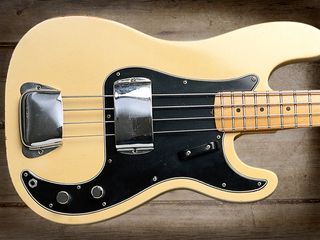
Fender Slab Body Precision

PRODUCED: 1965 - 1967
ORIGIN: USA
TYPE: Twin cutaway solid body, 4-string
NECK: Maple, bolt-on, 20 medium frets
SCALE LENGTH: 864mm (34-inch)
FINGERBOARD: Maple although at least one Rosewood board is known to exist
HARDWARE: Chrome raised tail bridge, tuners and cover plates
PICKUPS: Single Split Coil
CONTROLS: Volume & Tone
FEATURES: Slab body
FINISHES: Butterscotch Blonde and White
COMMENTS: You would be forgiven in thinking that this is just another Precision from a not particularly interesting time in its production history, but you'd be wrong.
For a start this model didn't initially appear on sale on American soil - it was a purely British phenomenon. Essentially it's an original slab body Precision from the early fifties but with the later, larger sized headstock as ordered by Arbiter in London.
Exactly what inspired the order is hard to discover but they caused interest as soon as they appeared, tickling the fancy of bassists like John Entwistle, Chip Hawkes (Tremeloes), Bob Daisley (Gary Moore, Ozzy Osbourne, Rainbow) and Eric Haydock (Hollies). Even Marc Bolan's bass player used one on Top Of The Pops in 1971 for Get It On.
It created enough interest and sales for a second batch to be made and some of these remained in the States. This is one of the most researched and coveted production Precisions ever, and it helped rekindle the interest in the original P-Bass and subsequently lead to the Telecaster Bass.
Fender Custom Shop recently introduced their Masterbuilt '66 Slab Precision Closet Classic Bass and a book called 'Fender Bass For Britain' by Barry Matthews gives the fullest possible account of this curious instrument.
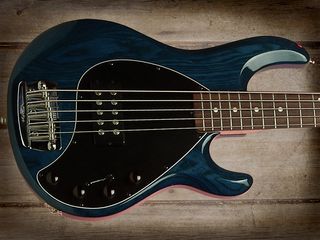
Music Man StingRay 5

PRODUCED: 1987 - Current
ORIGIN: USA
TYPE: Twin offset cutaway solid body, Active, 5-string
BODY: Ash
NECK: Maple, bolt-on, 22 high profile wide frets
SCALE LENGTH: 864mm (34-inch)
FINGERBOARD: Maple or Rosewood, pearl dot inlays
HARDWARE: Chrome 4/1 Schaller open gear tuners, hardened steel bridge plate
PICKUPS: Ernie Ball Ceramic Humbucker with phantom coil
CONTROLS: Volume, Treble, Mid & Bass, 3-way selector switch, edge mounted jack socket
FEATURES: Extended scratchplate, smaller bridge plate, surface stringing, 6-bolt neck plate
FINISHES: Sunburst, Trans Teal, Trans Red, Black, White, Custom Colours with matching headstock
COMMENTS: With a much more contoured body and a larger scratchplate taking care of pickups and controls, the StingRay 5 is instantly distinguishable from the classic 4-string version.
With a shorter bridge plate that finally dispensed with the string mutes, it was the first newly designed Music Man bass to be manufactured by the Ernie Ball Company and took its inspiration from their Silhouette guitar.
The 3-way selector offered a choice of series and parallel pick up combinations, and in 1991 the StingRay 5 was given a ceramic pickup with a phantom coil to reduce noise. The dual pickup model was introduced in 2005.
This has either two humbuckers or a humbucker and a single coil in the neck position, plus a 5-way selector switch. In 2006 a limited run had through-body stringing, an ebony fingerboard and a 5-bolt neck plate. A return to alnico pickups in 2008 gave the 5-string a new boost as it sounded much closer to the original 4-string Ray.
Also like the StingRay 4, the latest versions offer a piezo-loaded bridge for an expanded tonal range plus a fretless version with a pau ferro board and optional fret markers. Our picture shows a Trans Teal StingRay 5 alongside a natural finish classic fretless StingRay 4.
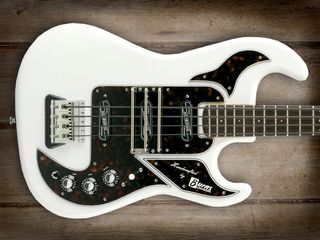
Burns Shadows Bass

PRODUCED: Original run 1964 - 1965
ORIGIN: UK
TYPE: Solid body, offset double cutaway, 4-string
BODY: American Alder
NECK: Maple, bolt-on, 22 medium frets plus zero fret
SCALE LENGTH: 851mm (33½-inch)
FINGERBOARD: Rosewood with small white dot markers
HARDWARE: Chrome, Rezo-tube bridge/tailpiece, Van Gent black button open gear tuners
PICKUPS: Three Nu-Sonic type initially then changed to three Rez-o-Matic Bass versions
CONTROLS: Volume & two Tone, 3-way Selector Switch
FEATURES: Offset ‘toast rack’ wrist rest, large scrolled headstock, brown or grey tortoiseshell scratchplate
FINISHES: Polyester White, Greenburst
COMMENTS: When Hank Marvin of The Shadows asked Burns to make him a signature guitar a matching bass was also required to keep the uniformed look associated with the band.
The Shadows Bass was duly designed and built for John Rostill and such was the interest it created a small production run was begun. Rostill’s bass was actually slightly different to the production models with ‘Marvin’ on the headstock and both the pickups and the toast rack palm rest were not set at an angle.
The Rezo-tube bridge/tailpiece featured four individual aluminium tubes for added resonance so the strings are loaded through the body. Unusually the upper strap button was located behind the upper body horn rather than on the end.
Following the initial run the Shadows Bass was continued by the new parent company Baldwin from 1965 - 1970. It developed an elongated scroll headstock and staggered Schaller tuners but these are less sought after today.
With the relaunch of the Burns name it reappeared during the nineties as a very favourable edition with Rez-o-Matic pickups and even a fretless version then in 2005 Burns of London acquired Rostill’s original bass and produced a limited run of The Shadows Bass 1964 which was modelled as close as possible to this lovely instrument. However it also benefited from an improved bridge and enhanced electronics with push/pull tone pot for two extra pickup combinations plus a 5-way selector switch.
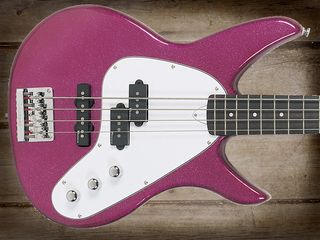
Vaccaro X-Ray Bass

PRODUCED: 1998 - 2002
ORIGIN: USA
TYPE: Solid body, offset double cutaway, 4-string
BODY: Alder
NECK: Aluminium/Maple, bolt-on, 20 medium frets plus zero fret
SCALE LENGTH: 864mm (34-inch)
FINGERBOARD: Ebanol, pearl diamond inlays
HARDWARE: Chrome, Vaccaro V200 Fully Adjustable Bass Bridge, regular open gear bass tuners
PICKUPS: Vaccaro V2 P and J Style Set (Basslines)
CONTROLS: Volume, Tone & Balance
FEATURES: Aluminium neck core, Tuning Fork Headstock
COMMENTS: Henry Vaccaro Senior was one of the founding members of Kramer Music Products who introduced the amazing power-forged aluminium T-neck in 1976.
He was the company chairman from 1982-1988 but dissolved the company when testing began on the new aluminium V-neck, and the Vaccaro brand was launched. Unlike the Kramer T-Neck, which was troubled by temperature change, cold to the touch and extremely heavy, the V-Neck used an aluminium core surrounded by wood, and so was considerably lighter, resistant to temperature changes and also employed a truss rod.
Whist many other basses also opt for a P/J pickup configuration the X-Ray has a distinctive edginess to its overall sound plus excellent sustain thanks to this unusual construction. Combined with that striking headstock it was a winner but sadly not enough to prevent the company closing in 2002. Orange Sparkle was the signature colour but came in several other sparkling finishes as well as black.

Fender Telecaster Bass Series 2

PRODUCED: Second Version 1972-1979
ORIGIN: USA
TYPE: Twin cutaway solid body, 4-string
BODY: Ash
NECK: Single piece hard rock Maple, bolt-on, 20 medium nickel-silver frets
SCALE LENGTH: 864mm (34-inch)
FINGERBOARD: Maple, black dot inlays
HARDWARE: Chrome Pickup cover, 2 saddle bridge, tuners and bridge cover plate
PICKUPS: Fender Humbucker
CONTROLS: Volume & Tone
FEATURES: Telecaster shaped headstock, finger rest, Tilt neck micro adjustment, Bullet truss rod adjuster
FINISHES: High-gloss Blonde, Sunburst & Custom Colours
COMMENTS: When Fender released the first series of the Telecaster Bass in 1968 very few actually left the States. This model was essentially the first reissue Fender, as it was fashioned after the original Precision design. Ever the tastemaker, John Entwistle of The Who bought one.
However, in the UK we became far more familiar with the Telecaster Bass Series 2 that was introduced in 1972. This is a much-modified version, and is fitted with a humbucking pickup rather than the standard single coil unit. This fully adjustable pickup was actually designed by Seth Lover, who had been hired by Fender in 1967 - a job that ended his long association with Gibson.
It gave the bass an entirely new voice for Fender, as unsurprisingly its tonal qualities were much more Gibson like. The scratchplate was a new design too and incorporated the controls, however the jack socket remained on the lower body edge. It was also given the newly designed 3-bolt neck plate with tilt adjustment and a bullet style truss rod adjuster.
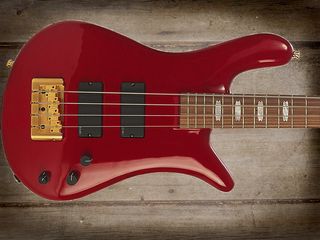
Stuart Spector Design SSD NS-4 Bass

PRODUCED: 1990 - 1998
ORIGIN: USA
TYPE: Twin cutaway solid body, active 4-string
BODY: Quilted Soft maple
NECK: 3-piece laminated Maple, neck through body, 24 medium frets
SCALE LENGTH: 864mm (34-inch)
FINGERBOARD: Pau Ferro, nipped oval-shaped mother of pearl inlays
HARDWARE: Gold plated brass bridge and M4-type tuners, brass nut
PICKUPS: Pair of active EMG Soapbars
CONTROLS: Volume, Pan & Dual Concentric active EQ of Bass and Treble
FEATURES: 18-volt on board electronic circuit, Graphite reinforced single truss rod, black-faced headstock,
FINISHES: Translucents including Red Wine (as here), orange, burgundy and natural
COMMENTS: For the uninitiated, the NS stands for Ned Steinberger who came up with the ergonomically designed concave body that was a total revelation to players when it was first introduced, as it simply melded into the player’s own body.
The first NS-Bass appeared in 1977 and was acknowledged not only for its design but also the dynamic sound. These handmade instruments soon became part of the Kramer Guitar Company in 1985, until that company’s demise in 1990. At that point Stuart started Stuart Spector Designs, and it’s from this SSD period (1995 in fact) that our example comes from.
Finally in 1998 Stuart regained the Spector name and trades as such, with the NS-4 still very much in demand. This particular colour combination of red body and gold hardware is a true delight to the eyes and really smacks of class.
The headstock joins the deep profile neck with a gentle volute-like bump, which gives extra strength to this vulnerable area, and the substantial bridge and pickups are neatly routed well into the body so as not to visually dominate this succulent presentation. With both a brass nut and a brass bridge mass the strings are exceptionally resonant and backed by the powerful on board circuitry - it’s no wonder this bass sounds simply fantastic.
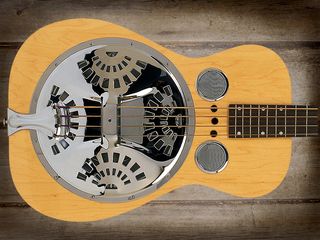
Dobro D Deluxe

PRODUCED: 1995 - 2000
ORIGIN: USA
TYPE: Acoustic body with single cone resonator, 4-string, fretted or fretless
BODY: Bound laminated maple top, back & sides
NECK: Maple, bolt-on, 24 fine frets
SCALE LENGTH: 864mm (34-inch)
FINGERBOARD: Rosewood, pearl dot inlays
HARDWARE: Aluminium resonator, spider bridge/trapeze tailpiece
FEATURES: Two screened sound holes with three uncovered smaller ones evenly spaced between, regular shaped Dobro headstock with two a side tuners
FINISHES: Natural high gloss & Darkburst
COMMENTS: Sometimes the unexpected leaves a lasting impression and that certainly is the case with this fully acoustic instrument from Dobro.
True to the legendary status that goes with the name this is fitted with a resonator, but it just happens to be a bass guitar. The original resonator idea stems from the thirties as a way to make an acoustic guitar sound louder.
The same could be said of the Dobro Bass but these days it's more a question of the distinctive sound that appeals rather than the added volume although, as this has no electronics at all, perhaps that is a distinct advantage.
Twenty-four frets is all very well but few of us could comfortably handle the uppermost, although the double dots on the fingerboard up here certainly stand out. Being full scale it does look rather over long, but fitted with a brand new set of phosphor bronze bass stings it has a deliciously brash but fruity sound. Sadly it was just a phase and all Dobro bass resonators ceased production at the turn of the century.
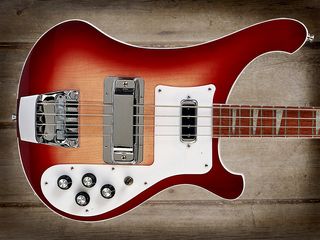
Rickenbacker 4003

PRODUCED: 1979 - Current
ORIGIN: USA
TYPE: Twin cutaway solid body, 4-string passive
BODY: Bound, Maple wings aside the neck block
NECK: Maple, through neck, 20 jumbo frets
SCALE LENGTH: 844.6mm (33¼ -inch)
FINGERBOARD: Rosewood, lacquered with pearloid triangle inlays sometimes called Sailfins
HARDWARE: Chrome, Rickenbacker solid bridge/tailpiece, Schaller open gear ‘shamrock’ tuners, string damper
PICKUPS: 2 Rickenbacker Singlecoils
CONTROLS: Volume & Tone for each pickup plus 3-way selector switch
FEATURES: Bound body, Mono and Rick-O-Sound stereo outputs, distinctive white scratchplate
FINISHES: Fireglo, Jetglo, Mapleglo, Midnight Blue, White
COMMENTS:When Rickenbacker introduced the 4003 bass the 4001 was still in production, in fact it lasted until 1985 and with relatively little between the two visually and general sound characteristics, its very existence may seem curious.
The truth is, the 4001 had a few design problems - particularly with the truss rod adjustment cavity at the headstock. As the neck was very slim there was actually very little wood around this cavity, headstock breaks were always a danger (personal experience here) and neck bowing could be a problem.
The 4003 was designed to take care of that by adding extra meat to the whole neck. Of course this gave it a rather more substantial feel, so the new designation was justified. Rickenbacker also improved the dual truss rod system and altered the electronics by removing the bridge pickup capacitor and improved 'hotter' pickups, which are much better balanced than on the 4001.
Later versions of the 4003 would include a push/pull pot to engage this replaced capacitor. This bass masters the iconic looks and sound that Rickenbacker basses are known for, particularly when engaging Rick-O-Sound, which provided a stereo output jack so that you can run each pickup into a designated amplifier.
But whether mono or stereo this will grunt and growl like no other, although as McCartney proved it can also sound very sweet. Also available as the 4003S unbound mono version, 4003FL fretless, 4003S/5 unbound 5-string and 4003S/8 unbound 8-string, with all S-versions having dotted inlays.
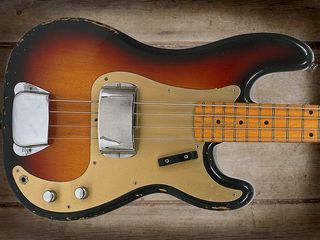
Fender Precision 1957

PRODUCED: 1957-1981
ORIGIN: USA
TYPE: Solidbody, Passive 4-string
BODY: Twin cutaway, Ash
NECK: Solid Maple, skunk stripe covers truss rod, 20 fine frets
SCALE LENGTH: 864mm (34-inch)
FINGERBOARD: Originally no separate board, part of the maple neck with black dot inlays. On Rosewood board models the dots were white clay type
HARDWARE: Chrome, 4-saddle bridge, open reverse gear tuners
PICKUPS: Fender split-coil 8-pole
CONTROLS: Volume & Tone
FEATURES: Gold anodised metal scratchplate incorporating pickup, controls and jack socket, surface stringing, chrome cover plates over bridge and pickup, finger rest with two screws
FINISHES: Sunbust, Black, Antique White and Custom Colours
COMMENTS: This was the third re-modelling of the Precision Bass in just six years of being in existence, but this is the defining moment as it’s essentially the same production line bass sold by Fender today.
Some of what we see here was introduced on the transitional P-Bass, the first round of modifications, that introduced body contouring. Here the headstock shape has adopted the Strat styling to overcome the dead spot on the upper string that was a problem with the initial design.
Along with the fantastic split-coil pickup which allowed for more adjustment and a well balanced sound, came a four-saddle bridge and anodised scratchplate, which helped in screening the electronics. In 1959 white and tortoiseshell laminated scratchplates were introduced, and these had a metal screening plate fitted beneath.
The solid maple neck was phased out around 1959 in favour of a rosewood board, although a maple board was an option again around 1967. Fretless was also introduced in 1970 with either board. There were special editions too like the Slab Body, which can be found in this collection, and the Antigua Precision with its distinctive finish. Whatever your personal P-Bass choice this was truly the defining moment.
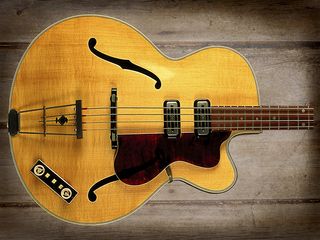
Hofner President Bass 500/5
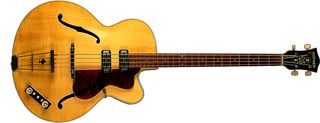
PRODUCED: 1957 - 1979
ORIGIN: Germany
TYPE: Single cutaway acoustic archtop body, 4-string
BODY: Fully Bound Flamed Maple including f-holes
NECK: Maple, set neck, 22 medium frets + zero fret
SCALE LENGTH: 760mm (30-inch)
FINGERBOARD: Rosewood, white dot inlays
HARDWARE: Chrome Lyre tailpiece, wooden adjustable bridge, guitar sized open-gear tuners with plastic blades
PICKUPS: Two Hofner ‘Toaster’ pickups
CONTROLS: Two Volume controls and switches for Rhythm/Solo, Bass On/Off & Treble On/Off all located on separate on Mother-Of-Pearl plate
FEATURES: F-holes, mother of pearl Lilies logo on headstock, Tortoiseshell floating scratchplate
FINISHES: Natural Blonde, Tobacco Sunburst
COMMENTS: The earliest examples of these basses were imported into the UK by Selmer Music in London's Charing Cross Road, and were sold simply as the Hofner Bass Guitar.
Selmer soon gave the different models names rather than using their designated numbers. The President or 500/5 originally had Hofner Black Bar pickups. Over the course of time this model has become known as the Stu Sutcliffe as that's what the artist/bass player used during his time with the Beatles in Hamburg.
The earliest models had an elliptical control plate and featured a hollow body with no centre block, making it extremely light in weight. The body depth was reduced by the mid sixties, and thanks to a trim short scale neck it was an easy bass to master.
The Toaster style pickups appeared around 1960 but by the end of the decade these were replaced by the Type 512B pickups. Also a larger control plate was introduced for some whilst on others the controls were set into the body surface. The bridge is Hofner's usual wooden design with fret wire saddles, and sounds like most of their hollow bodied models, full and fat, with good thump and a nicely balanced output across the strings. The President is still very popular in the new Contemporary Series made in the Far East.
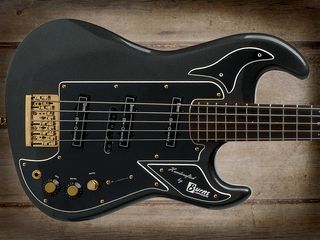
Burns 5-string Bass

PRODUCED: 2001 – Custom Order
ORIGIN: UK
TYPE: Twin cutaway solid body, 5-string
BODY: Alder
NECK: Beech, bolt-on, 22 medium frets plus zero fret, white dot inlays (these are smaller after 12th fret)
SCALE LENGTH: 864mm (34-inch)
FINGERBOARD: Rosewood
HARDWARE: Gold plated Burns Transducer T/R Bridge System, Schaller open gear tuners with ebony buttons
PICKUPS: 3 Burns Bar-O-Matik bass pickups, the middle one being a humbucker
CONTROLS: Volume, Tone, Transducer Blend control & 5-way blade selector switch
FEATURES: Deep scrolled headstock, bridge incorporates an active Transducer system that allows the volume and tone of each sting to be adjusted individually
FINISHES: Black
COMMENTS:This has to be one of the most unexpected models to be produced by Burns London, not simply because it’s a 5-string bass but more that it has advanced electronics incorporating an active transducer with a battery powered preamp.
Development began in 1998 when Shadows’ bassist Alan Jones wanted active electronics in his P-bass, which Burns duly provided. However, he also fancied a 5-string, so the company went ahead with this prototype. Due to other commitments, it was shelved before it could be completed.
Fortunately, an acquaintance of Jones commissioned the bass to be finished. The active transducer system helped the bass to achieve a simulated acoustic sound as well as offering a much wider range of tones overall.
The scrolled headstock had seen a few changes since its initial introduction on the Shadows Bass in 1964, but here it is back in all its glory, looking even better thanks to the longer and narrower dimensions of the headstock required to make way for the extra tuner. Sadly it never went into production although we do know of a different Burns 5-string model. Watch this space!
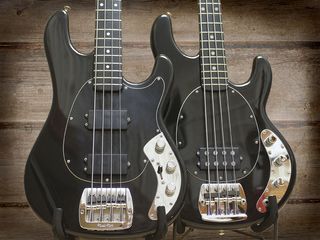
Music Man Cutlass Bass
PRODUCED: 1982 - 1987
ORIGIN: USA
TYPE: Twin cutaway solid body, active 4-string
BODY: Alder or Ash
NECK: Graphite (made by Modulus for Music Man), bolt on, 20 jumbo frets
SCALE LENGTH: 864mm (34-inch)
FINGERBOARD: Rosewood with pearl block inlays
HARDWARE: Chrome
PICKUPS: Regular Music Man Humbucker on the Cutlass I & a pair of smooth surface humbuckers on the Cutlass II
CONTROLS: Volume, Active Treble & Bass - Cutlass I; Volume, Active Treble & Bass & Pickup selector switch - Cutlass II
FEATURES: Cutlass I: through body or top-load stringing; Cutlass II top-load only; vastly different shaped scratch plate, control plate and bridge units
FINISHES: Mainly all black, Natural, White, Red
COMMENTS: The Cutlass I and II were Music Man’s attempt to join in the graphite neck revolution by teaming up with Modulus Graphite to produce two short-lived models.
Earliest examples used existing body stock (some going back to 1979) and three-bolt neck plates, although these were soon changed to rectangular 4-bolt plates. The 3-bolt version also had through-body stringing whereas the 4-bolt was fitted with a top load bridge unit.
The Cutlass I was essentially a Stingray and the Cutlass II a Sabre, each using those distinctive body shapes and hardware, although the Cutlass II did not retain the exposed pole pieces as seen on the Sabre’s twin pickups and also offered a simplified circuit too.
The Cutlass may have been all about the graphite neck but it was obviously not that popular at the time as very few units were actually built. They are pretty special, however, as Dave Swift (owner of these two basses) explains,
“I had a Cutlass I that I bought from a shop in Birmingham back in the 80s. I believe it was one of the first Cutlass basses to turn up in England, if not the first, and most of them were all black, but mine had a beautiful natural ash body. Unfortunately I sold it! I now have a Cutlass I and II, both black, and even though these are also very rare and collectible, I wish I still had my original natural one.”
Our sincere thanks go to Dave Swift for his input and to Lars Mullen for the pictures.
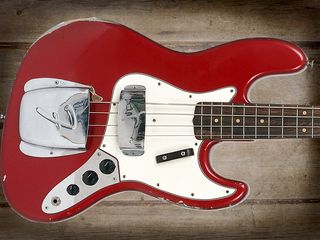
Fender Jazz Bass Pre-CBS Custom Colour

ORIGINALLY PRODUCED: 1962-1965
ORIGIN: USA
TYPE: Solid body, Passive 4-string
BODY: Ash, Offset-waist twin cutaway
NECK: Maple, bolt-on, 20 fine frets
SCALE LENGTH: 864mm (34-inch)
FINGERBOARD: Rosewood, clay dot inlays
HARDWARE: Chrome, 4-saddle raised tail bridge, two cover plates – the bridge cover featuring the stylised ‘Fender ‘F’, open reverse gear tuners
PICKUPS: Two 8-pole single coils
CONTROLS: 2 Volume Controls & Master Tone
FEATURES: Controls and jack socket on chrome plated ‘bell’ plate, ultra slim neck, sweet spot sounds
FINISHES: Custom Colours with matching headstock, Candy Apple Red (as here), Teal Green, Lake Placid Blue, Fiesta Red and Burgundy Mist were just some of the known colours
COMMENTS: This was the second version of the magnificent Jazz Bass and is displayed here in its full Custom Colour with matching headstock glory. The standard colours were available too of course, but they had the natural finished headstock.
The sometimes troublesome dual concentric controls were dumped for this simpler circuit of individual volumes with a master tone (smaller knob) on the bell plate. This also helped to create the sweet-spots where the blending of the two pickups seems to turn ‘hollow’ for a really pleasing and funky sound.
This Jazz bass has standard ‘elephant ears’ or ‘shamrock’ open gear tuners that operate backwards compared to modern day Fenders. Also some models are known to exist with cool oval blades, something that Fender used a little later but never caught on. We think Fender should bring them back as an alternative again. A truly gorgeous bass that’s still as good as anything on the market today.
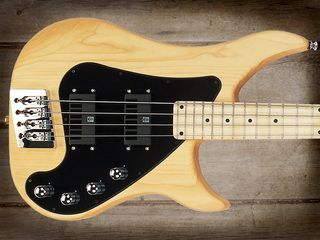
Vigier Excess Bass

PRODUCED: 1996 - Current
ORIGIN: France
TYPE: Twin cutaway solid body, active 4-string
BODY: Alder
NECK: 90/10 Maple/Carbon Fibre, bolt-on, 24 medium frets plus zero
SCALE LENGTH: 864mm (34-inch)
FINGERBOARD: Maple
HARDWARE: Chrome offset bridge, Schaller sealed gear tuners,
PICKUPS: Two Benedetti single coils – manufactured for Vigier
CONTROLS: Volume, Pan, Bass & Treble
FEATURES: Carbon fibre rod inserts in neck and no truss rod, choice of high or low impedance, hum-cancelling trim pot, edge mounted upward slanted jack socket,
FINISHES: Natural Matt (as here), Clear Black, Clear Red, Antique Violin, Ash & Ocean Blue
COMMENTS: Although by no means the first bass guitar from designer Patrice Vigier, the Excess was the first to offer a more conventional stance, and as such was a breakthrough for the company. The idea of a carbon fibre reinforced neck without a truss rod may sound ambitious but it actually works beautifully. Endorsee Roger Glover famously supported the bass on two blocks then stood on the bass without any ill effect to the bass whatsoever!
The offset, fully adjustable bridge is a particularly well designed unit that fully accepts the string ends. The active electronics are pretty serious too, as the EQ controls offer a cut/boost of +/-20dB so the bass certainly lives up to its name, and the on-board circuitry also allows the choice of high or low impedance and a trim pot for hum-cancelling. This effectively allows the use of extra long leads on stage without any power loss and higher quality DI in the studio.
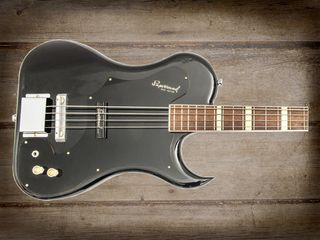
Supersound SCB Bass

PRODUCED: 1958
ORIGIN: UK
TYPE: Solid body, single cutaway, 4-string
BODY: Mahogany
NECK: Non specific, glued-in, V-profile, 20 heavy frets plus zero
SCALE LENGTH: 775mm (30½-inch)
FINGERBOARD: Bound rosewood, white plastic block inlays
HARDWARE: chrome, single bar bridge, Framus guitar tuners with fancy buttons and bone posts, block-type tailpiece with metal cover
PICKUPS: Supersound Hi-Fi single-coil. Equipped with a bar-magnet and suitably branded black plastic cover
CONTROLS: Volume and Tone
FEATURES: Front & rear contouring, long smooth and chamfered heel
FINISHES: Originally white as requested, resprayed black later on
COMMENTS: Back in 1958 Supersound added guitars and basses to their amplifier range, and enlisted the help of Jim Burns who was experimenting with instruments at that time. It was a short lived association but it did produce this, the first solid bass guitar built in Britain, commissioned by Teddy Wadmore who was the bassist with the Ted Taylor Four.
He’d managed to borrow a Fender Precision Bass from a US serviceman and was totally blown away with it, so showed it to Alan Wootton and Jim Burns at Supersound. The SCB (Single Cutaway Bass) is obviously far from being a clone but it does have the badged pickup in the same position as the Fender. It’s a shorter scaled instrument too with guitar sized tuners, and in order to produce enough clearance for the posts they are fitted into a recess at the rear of this substantial headstock.
Not only was this the first British solid bass guitar, it’s currently the only known example in near-original, fully playable condition and indeed it still feels and sounds amazingly good. Our thanks go to Guy MacKenzie for the picture and for allowing us to play this historically significant bass and to the legendary Paul Day for the historic details.
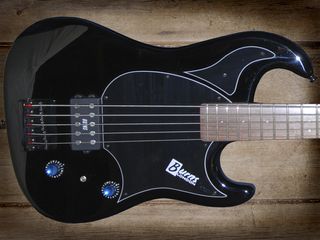
Burns Marquee 5-String Bass

PRODUCED: 2001 – One Off
ORIGIN: UK
TYPE: Twin cutaway solid body, 5-string
BODY: Alder
NECK: Maple, bolt-on, 20 medium frets,
SCALE LENGTH: 8mm (33½-inch)
FINGERBOARD: Rosewood
HARDWARE: Bright Black anodised raised tail bridge & Schaller sealed gear tuners in a 1 over 4 configuration
PICKUPS: One Burns split humbucker
CONTROLS: Master Volume, Master Tone & Mini Coil Switch
FEATURES: Reversed Bat-Wing headstock,
FINISHES: Black with matching headstock
COMMENTS: This is a second one-off from Burns built in 2001 and it’s another very distinctive 5-String bass, loosely modelled on the Burns Jazz Bass design from 1964 that was later revamped as the Marquee Bass in 2000.
The reversed headstock is a Burns first, the dot inlays seem rather too small on such a wide fretboard and the two piece scratchplate is an unusual shape. The MM styled humbucker is the real surprise here though, and is neatly linked to the switch between the controls allowing the unit to be used either as a pair of single coil or with both coils together.
Jim Burns was notorious for producing custom ordered one-offs, prototypes and ‘bitsas’ and it’s great to know that Burns London will do the same if the opportunity presents itself. Our sincere thanks go to Barry Gibson of Burns for providing the picture and this information.
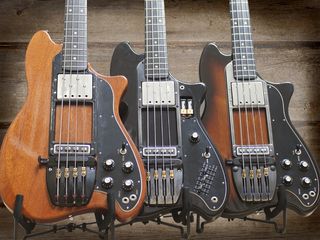
Ovation Magnum I/II
Ovation Magnum I
PRODUCED: 1974 - 1982
ORIGIN: USA
TYPE: Double off-set cutaway body, passive 4-string
BODY: Solid one-piece Honduras mahogany
NECK: Mahogany, graphite reinforced, glued and bolted, 20 jumbo frets or fretless
SCALE LENGTH: 864 mm (34-inch)
FINGERBOARD: Rosewood stained ebony with pearl dot inlays
HARDWARE: Chrome, cast aluminium tailpiece with individually adjustable solid brass saddles, Schaller semi-open gear tuners
PICKUPS: Humbucker with individual volume controls, Double coil with U-shaped pole pieces
CONTROLS: Volume & Tone for each pickup, 3-way pickup selector switch
FEATURES: Mono and Stereo output jacks, lever action string mute, aluminium bezel around pickups
FINISHES: Natural, Cherry, Sunburst & Custom Colours
COMMENTS: Ovation’s first bass guitar was the Typhoon, a thinline semi construction similar to a Hofner Verithin released around 1968/9, but it created little interest. Determined to do better with their first solid bodied bass the Magnum was designed to be the ultimate bass guitar to date. It was certainly packed with unusual features, particularly regarding the pickups.
The bridge unit has U-shaped pole pieces wound in pairs like a split-coil pickup but the huge bridge humbucker has individual coils wound round each pole piece and each coil has its own volume control for perfect string balance. This is certainly a pretty cool thing to have. The bridge offers very precise adjustment for scale length yet changing strings is quick and easy.
In order to get full use of the stereo function the Magnum was provided with a splitter lead for the stereo output jack so you could either use both channels in your bass amp or two completely separate rigs for a monster sound and delivery. Sadly however, the Magnum is just not a sexy looking instrument and although it sounds great it weighs a lot too, so it never achieved the popularity that was expected. They did produce a more regular shaped twin cutaway with a less cluttered appearance in 1978 but sadly this also failed to capture the imagination and was withdrawn in 1983.
Ovation Magnum II
PRODUCED: 1974 - 1982
ORIGIN: USA
TYPE: Double off-set cutaway body, Active 4-string
BODY: Solid one-piece Honduras mahogany
NECK: Mahogany, graphite reinforced, glued and bolted, 20 jumbo frets
SCALE LENGTH: 864 mm (34-inch)
FINGERBOARD: Rosewood stained ebony with pearl dot inlays
HARDWARE: Chrome, cast aluminium tailpiece with individually adjustable solid brass saddles, Schaller semi-open gear tuners
PICKUPS: Humbucker with individual volume controls, Double coil with U-shaped pole pieces
CONTROLS: Master Volume & 3-band EQ, 3-way pickup selector switch
FEATURES: Lever action string mute, aluminium bezel around pickups
FINISHES: Natural, Sunburst, Black,
COMMENTS: Not wishing to miss a trick, along with the passive Magnum 1 Bass Ovation also produced the Magnum II, an all active unit that provided even more tonal response and opportunities.
The 3-band EQ offered Bass, 400Hz and Treble each as a double slider with +/- 12dB adjustment. To power the circuit two PP9 batteries were housed in a compartment by the lower cutaway underneath a separate section of the scratchplate. The individual volume controls for the pole pieces on the humbucker were accessed through the four holes provide using a regular screwdriver. When adjusted well this was produced a very well balanced instrument from string to string.
This highly sophisticated circuitry gave the Magnum II a cleaner yet meatier sound than the passive version and was way ahead of its time but still failed to find favour with enough players to keep it in production any longer. Our sincere thanks to Dave Swift for use of his basses and Lars Mullen for the pictures.
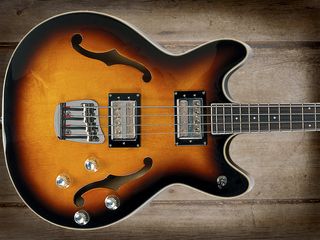
DeArmond Starfire Bass
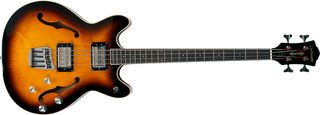
PRODUCED: 1997 – 2000 approx
ORIGIN: Korea
TYPE: Double cutaway semi-hollow body, passive 4-string
BODY: Bound laminated maple with two f-holes
NECK: Maple set-neck, 21 jumbo frets
SCALE LENGTH: 781mm (30.75-inch)
FINGERBOARD: Rosewood, bound with dot inlays
HARDWARE: Chrome, stylised Bridge/tailpiece with individually adjustable saddles, Schaller sealed gear tuners
PICKUPS: Pair of DeArmond 2B Dual-coil humbuckers made in USA
CONTROLS: Volume & Tone for each pickup, 3-way pickup selector switch
FEATURES: Semi-hollow body, short scale length
FINISHES: Crimson Red Transparent, Black & Antique Burst
COMMENTS: The full designation for this bass is ‘DeArmond by Guild’ and represents a budget priced reintroduction of the Guild Starfire Bass following the Fender buyout of the company in 1995. The Guild original ran from 1964 to 1977, when it failed to inspire the new generation of super bass players.
This DeArmond version revived the interest however, being very well constructed with a solid core to the body and set neck. It offers a vintage vibe when playing, with a surprisingly full sound although somewhat brighter than the early version, mainly due to the simplified circuitry and DeArmond USA pickups rather than the original Guild units.
What makes it important and collectable is that it sparked enough appeal for Fender to follow up with a new Starfire II bass under the Guild banner in 1998. What’s also curious about this model is that it was never for sale in the USA although even there the interest in these budget-priced instruments was undeniable.
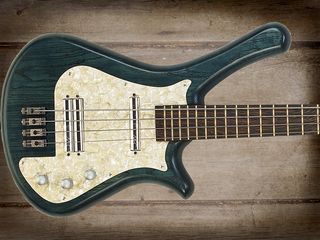
Warwick Fortress Flashback

PRODUCED: 1996 - 1999
ORIGIN: Germany
TYPE: Double cutaway solid body, bolt-on passive 4-string
BODY: American Swamp Ash
NECK: Wenge, Brass Just-A-Nut, 24 jumbo frets
SCALE LENGTH: 864mm (34-inch)
FINGERBOARD: Wenge with side dot inlays only
HARDWARE: Chrome/Steel, stylised Bridge/tailpiece with individual adjustable saddles, Hipshot tuners
PICKUPS: MEC J-type and Double J-type in ‘Lipstick Tube’ surrounds
CONTROLS: Volume, Blend, Tone with pull switch for coil-tap on the humbucker
FEATURES: Pearloid scratchplate for added retro vibe
FINISHES: Stained Oil in Mexican Green, Ocean Blue, Indian Blue, Nirvana Black, Burgundy Red, Turquoise Blue & French Violet. Also same colours in gloss plus Antique Tobacco & Honey Violin
COMMENTS: In spite of the Flashback designation and the unusual adoption of fifties styling on the pickups and scratchplate, this was a bang up to date offering from Warwick when it first hit in 1996.
This was a time when the Danelectro Lipstick Tube style pickups were experiencing renewed interest, so using a similar look on the MEC units here was a brilliant design move. However, the 2-Tek bridge assembly is a masterpiece of engineering - the bulk of the unit is hidden within a rear body cavity, with only the four individual saddles appearing through slots cut through the body surface, making them look like four separate bridge units.
The coil tap on the humbucker widens the tonal range enormously and offers some extra bite as well. The neck meanwhile is surprisingly slim, being only 38mm at the nut and here the brass Just-A-Nut is the original Warwick design that offers additional height adjustment for the strings. It was relatively cost effective instrument at the time and was offered in a fantastic range of colours in both stained oil and gloss finishes.
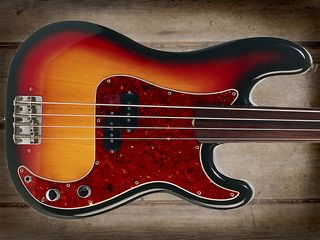
Fender Standard Precision Fretless

PRODUCED: 1970-81
ORIGIN: USA
TYPE: Solid body, double cutaway, passive 4-string
BODY: Ash or Alder
NECK: Hard Rock Maple, bolt-on (4-bolt neck plate)
SCALE LENGTH: 864mm (34-inch)
FINGERBOARD: Rosewood, (Maple as option) 9 side dot position markers at major fret locations
HARDWARE: Chrome plated raised tail bridge and open gear tuners, supplied with both pickup and bridge cover plates.
PICKUPS: Regular 8-pole split-coil
CONTROLS: Volume & Tone
FEATURES: Truss rod adjustment at body end, finger rest fitted as standard from 1976, supplied with flatwound (tapewound) strings
FINISHES: Fender ‘Thick Skin’ high gloss finish in 3-Tone Sunburst, Black, Natural & Butterscotch
COMMENTS: Fretless bass guitars have been about since the Ampeg mid-sixties model, but they made little impact at first. However, Rick Danko of The Band started using a fretless Ampeg which he modified with Fender pickups, which may have played a part in Fender producing what was essentially a regular Precision bass but without frets.
It was offered with a choice of rosewood or maple fingerboards and curiously, in spite of the more tactile requirements of a fretless bass, it was supplied with both the bridge and pickup cover plates fitted (if you look closely at the picture the screw holes can be seen and those for the finger rest).
Production was dropped in 1981, which was rather unfortunate really as the fretless revolution was just about to start. Fender Japan made a far more adventurous version known as the A/E Fretless Precision – look out for more about that at a later date.
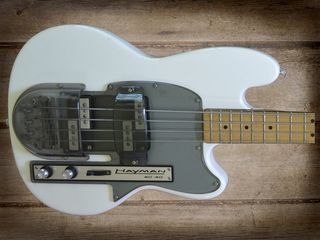
Hayman 40 40 Bass

PRODUCED: 1970 – 1973/74
ORIGIN: UK
TYPE: Solid slab body, Passive 4-string
BODY: Obeche (African hardwood), twin cutaway
NECK: Maple, 20 jumbo frets plus zero fret
SCALE LENGTH: 864mm (34-inch)
FINGERBOARD: Maple, very thin black binding to edge
HARDWARE: Steel & Perspex, sturdy 4-saddle bridge, open gear shamrock tuners
PICKUPS: Superflux double-pole staggered pick-ups positioned over a metal ‘vibrosonic chamber’ plate.
CONTROLS: Volume & Tone plus a 3-way selector switch
FEATURES: Name featured on the rectangular control plate, two smoked transparent Perspex cover plates, same material for complex scratchplate, round hole through the headstock for a clear ‘H’ disc insert, hand-carved ivory nut
FINISHES: White, Tobacco 2-tone, Cherryburst, Black & Natural
COMMENTS: The Hayman Company was formed in 1969 when Jim Burns and Ivor Arbiter went into partnership. Also involved was Bob Pearson from Vox (designer of the Phantom range) and two former Burn’s colleagues, Jack Golder and Norman Holder, who took care of the woodworking and truss rod engineering.
Hayman produced three guitar designs but the 4040 was the only bass. Something of a heavy weight however, these basses were good to play and produced sounds somewhere between a P-Bass and a Rickenbacker.
Each Superflux pickup had eight adjustable screw pole pieces so it was easy to balance the output from the strings, and they benefited from the hidden vibrosonic chamber beneath. Joint string trees neatly feed the strings from nut to tuners.
The bridge was a curious affair with a clear plastic anchor and the steel saddles on a separate plate. The slab body had minimal curving to the body edge front and back, and the overall shape is similar to the early Wal Pro basses that would appear a little later on.
The neck was fixed using a standard 4-bolt plate with a separate chromed plate displaying the serial number. Lefties were made to order. The company morphed into Shergold, controlled by Golder and Holder, after Jim Burns pulled out.
The confusion as to when production finished is due to their serial numbering system, which suggests some Hayman basses appeared in 1974. Our sincere thanks go to Guy MacKenzie for allowing access to his fascinating guitar collection.
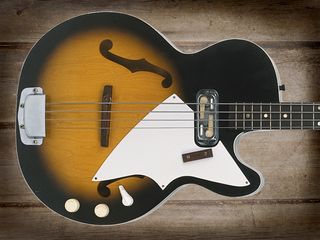
Harmony H22
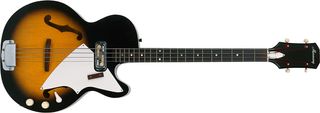
ORIGINALLY PRODUCED: 1961 - 1969
ORIGIN: USA
TYPE: Thinline semi-hollow, single cutaway, twin f-holes, Passive 4-string
BODY: Laminated maple top, back & sides, celluloid body binding
NECK: Maple, bolt-on, 20 medium frets, painted neck
SCALE LENGTH: 762mm (30-inch)
FINGERBOARD: Ebonised maple, dot inlays
HARDWARE: Guitar sized Waverly tuners with plastic buttons and ganged in pairs, adjustable rosewood acoustic styled single saddle bridge, covered tailpiece
PICKUPS: DeArmond GoldenTone
CONTROLS: Volume, Tone & Bass Enhancer (Bass/Baritone)
FEATURES: Stealth Fighter Jet single ply white scratchplate with wooden finger rest, 3 bolts to fix neck to body, truss rod adjusted at headstock
FINISHES: Sunburst Walnut
COMMENTS: This budget priced bass proved very popular from the outset as it offered a pocket friendly alternative to the mighty Gibson EB2 and the Epiphone Rivoli basses, and it sounded good too!
Light in weight, it was big on sound thanks to the DeArmond pickup and the Bass/Baritone selector switch that gave it just a little more edge if you wanted. The tailpiece was set at the edge of the body so long scale strings could be used successfully. This was important at the time as short scale strings were not that easy to find.
Championed in the UK by Muff Winwood with the Spencer Davis Group and Ronnie Lane of the Small Faces it has rightfully become an icon of the sixties. In 1969 it evolved into the H-22/1 with a twin cutaway body. The Harmony Company was finally wound up in 1975 but recently a reissue has emerged that is actually somewhat better constructed - and it’s still relatively cheap.
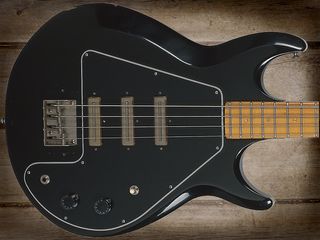
Gibson Victory

PRODUCED: 1981 - 1987
ORIGIN: USA
TYPE: Solid body, double cutaway, 4-string
BODY: Maple
NECK: Laminated Eastern Rock maple, bolt-on, 24 fine frets (21 are full frets)
SCALE LENGTH: 876mm (34½ -inch)
FINGERBOARD: Rosewood extended, angled at body end to match the scratchplate, offset pearl dot inlays
HARDWARE: Chrome, chunky Gibson TRI-4 ‘wedge’ bridge, Gibson badged winged open gear bass tuners by Gotoh
PICKUPS: Gibson VIIIB humbucker
CONTROLS: Volume & Tone, series/parallel switch
FEATURES: Black pickguard, black headstock face, chamfered body cutaways, Gibson ‘Diamond’ strap buttons, price included Gibson hard case
FINISHES: White, Silver, Antique Gold, Fireburst, Ebony & Cardinal Red
COMMENTS: Designed by Chuck Burge and Tim Shaw of Gibson’s Research & Development team, the Victory Bass was a fresh attempt to surpass Fender’s mighty Precision. In fact the initial idea was that the whole feel and playing experience of the Victory should be identical to a P-Bass.
The body cutaways were deeper however, and there was a 24 fret compliment. The wedge bridge is a very solid affair with little room for adjustment but perfectly acceptable. The circuitry was passive although some of the later Victory range featured an active system.
Most were fitted with flat wound strings as standard and this provided a serious thump of a sound. The Victory's downfall (as usual for Gibson) was the overall weight, but they are becoming popular again as they ‘downtune’ very successfully.
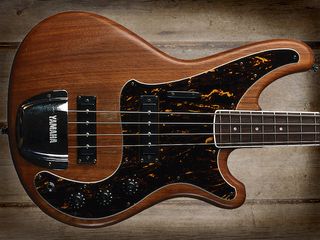
Yamaha SB55

PRODUCED: 1973 -1976
ORIGIN: Japan
TYPE: Solid body, double cutaway, 4-string
BODY: Nato
NECK: Maple, bolt-on, 20 frets
SCALE LENGTH: 857mm (33.75-inch)
FINGERBOARD: Bound rosewood, white dot inlays
HARDWARE: chrome, bridge, open gear bass tuners in line
PICKUPS: Pair of J-Type single coils
CONTROLS: Two Volumes & a master Tone
FEATURES: Yamaha badged bridge cover plate, ‘upside down’ headstock, tortoiseshell scratch plate, amp style skirted control knobs
FINISHES: Natural & Sunburst
COMMENTS: The SB55 was the first of Yamaha’s basses to offer more conventional body shaping, featuring a distinctive ‘hook’ at the end of the horns which would become something of a trademark.
Along with the J-Type pickups and associated circuitry, the SB55 had a bound neck with a typically Jazz-like slim profile. It offered a clear and clean sound too, which was even noticeable when played acoustically thanks to that Nato body.
There was also a deluxe version offered during this same time span, the SB75, which featured a bound ebony fingerboard with chevron block inlays. These basses were certainly a turning point for the company and along with the top model of the SB series, the SB1200S, they preceded the instrument that would finally see Yamaha recognised as a serious bass guitar manufacturer, the mighty BB.
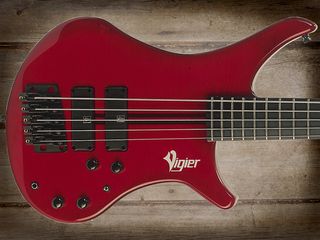
Vigier Passion Custom III 5-string

PRODUCED: 1983 - Current
ORIGIN: France
TYPE: Solid body, double cutaway, 5-string
BODY: Walnut core with flame maple top & back
NECK: Graphite reinforced maple, neck through body, 21 frets plus zero fret
SCALE LENGTH: 864mm (34-inch)
FINGERBOARD: Phenowood (Phenolic Resin), no inlays
HARDWARE: Brass black anodised offset bridge, black sealed gear tuners
PICKUPS: Pair of Vigier active Soapbars
CONTROLS: Volume, Pan, Mid Range Sweep, Passive Tone plus 3-way switch
FEATURES: Minimalist body, Graphite Nut, matching headstock
FINISHES: Translucent Cherry (as here) plus 12 other standard colours, Natural and 10 Custom Colours all in matt or gloss
COMMENTS: Vigier basses are always well built and each model is usually offered in many different finishes and available in 4-string, 5-string and fretless versions (with Delta metal fingerboard) as well as standard and custom models.
This Passion III from 1996 is no exception, with a through-neck construction that features a pair of graphite reinforcing strips that pass right into the body. The offset bridge design makes for very precise tuning and a low action. The sound is full and warm but with the ability to bite and growl thanks to the sensitive circuitry.
The compact asymmetrical body is light and comfortable to play, particularly for a 5-string, making the Passion a must-play bass that remains in production today.
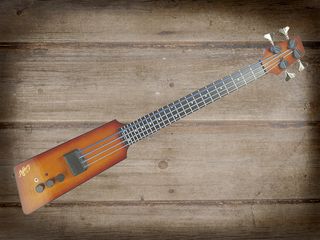
Hartke XK-4

PRODUCED: 1999 – 2004 approx
ORIGIN: Korea
TYPE: Double cutaway solid body, bolt-on active 4-string
BODY: Poplar
NECK: Vaccaro Aluminium T-Bar with Maple shell
SCALE LENGTH: 864mm (34-inch)
FINGERBOARD: Rosewood with 20 Nickel Silver medium frets plus zero fret, side dot inlays only
HARDWARE: Schaller 2000 Chrome Bridge and tuners
PICKUPS: Passive P/J pickups
CONTROLS: Individual Volume controls, dual concentric active Bass & Treble
FEATURES: Vaccaro neck, brushed aluminium scratchplate, super sustain qualities, 9-volt circuit,
FINISHES: Black, Metallic Purple Sparkle,
COMMENTS: The XK-4 is the budget priced alternative to the XL-4, which was built in New Jersey USA. Metal-necked basses have always been of interest as they naturally offer greater stability during the instruments life. However the nature of metal is that it’s initially cold to the touch and as it gradually absorbs heat its dimensions alter and in some circumstances this can affect the tuning.
Larry Hartke designed the XK-4 knowing these pitfalls and came up with the ingenious idea of giving the aluminium neck a maple shell. So whilst the inner construction of an aluminium T-Bar welded to the chrome plated headstock is pretty innovative, the feel is far more conventional if somewhat substantial.
So you get an extremely stable neck, a futuristic looking headstock but a conventional feel (plus the added benefit of superior sustain - according to the manufacturers, at least). Although the pickups are passive the 2-band active EQ gives this a lot more kick in the sound.
The chunky and solid Schaller bridge proves to be the perfect choice here as its chrome bulk matches the headstock beautifully. A 5-string with a pair of J-type pickups was also produced.
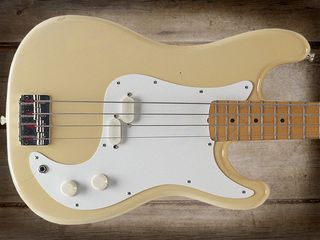
Fender Bullet B30

PRODUCED: 1982 - 1983
ORIGIN: USA
TYPE: Solid body, offset double cutaway, short scale 4-string
BODY: Alder
NECK: Maple, bolt-on, 19 medium frets, rear skunk stripe
SCALE LENGTH: 813mm (32-inch)
FINGERBOARD: Maple, black dot inlays
HARDWARE: Chrome, fixed 4-saddle bridge, regular open gear bass tuners
PICKUPS: Covered split-coil
CONTROLS: Volume & Tone cream non-skirted amp style
FEATURES: Telecaster bass style headstock, Fender F on neck plate, headstock decal features a star behind the word ‘Bullet’
FINISHES: Ivory, Red, Tobacco Sunburst, Walnut & Custom Colours
COMMENTS: Always keen to offer short scale models in their bass range, Fender introduced the Bullet in 1982. With its Tele-style headstock the Bullet is a visually much better proportioned bass than its Mustang and Musicmaster predecessors.
In true Fender fashion it makes use of earlier components like the Mustang down-sized split coil pickup and a pair of cylindrical amp knobs. The P-Bass style single ply white scratchplate makes this look like a real Fender design.
The Bullet was offered in two more versions, the B34 which was a full scale version and the B40 was given a 20th fret.

“A sophisticated, detailed design that produces highly expressive tones with immersive depth and dimension”: Boss unveils the Katana-Mini X, a portable $149 10W amp with FX, tuner and Bluetooth

“The bass solo in My Generation is one of the classic bass things of all time. And John Entwistle said it was the bane of his life”: Rick Wakeman explains the problem with recording a classic solo, and how he experienced it with Yes’s Close To The Edge

“A sophisticated, detailed design that produces highly expressive tones with immersive depth and dimension”: Boss unveils the Katana-Mini X, a portable $149 10W amp with FX, tuner and Bluetooth

“The bass solo in My Generation is one of the classic bass things of all time. And John Entwistle said it was the bane of his life”: Rick Wakeman explains the problem with recording a classic solo, and how he experienced it with Yes’s Close To The Edge
Most Popular







